Posted by Patrick Weiler on 07-06-2007 05:22 PM:
More Museum Rugs
Here are a few more rugs from the Tokat Vakif museum which we visited on one
of the pre-ICOC tours.
These are all flatweaves. I will post a few more
images in the next few days. These are not extremely old, but would certainly
rate a second glance if found at your local rug store.
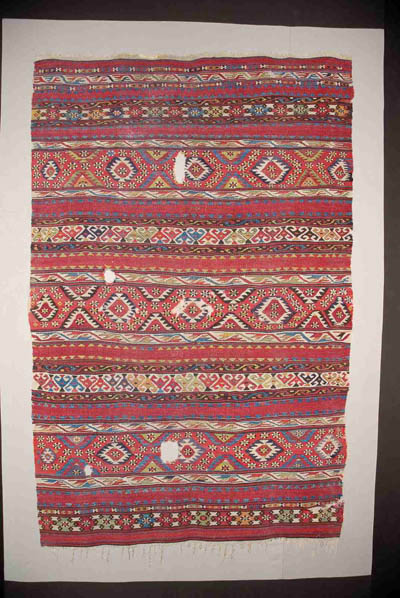
I believe these next two are
grain bag faces.
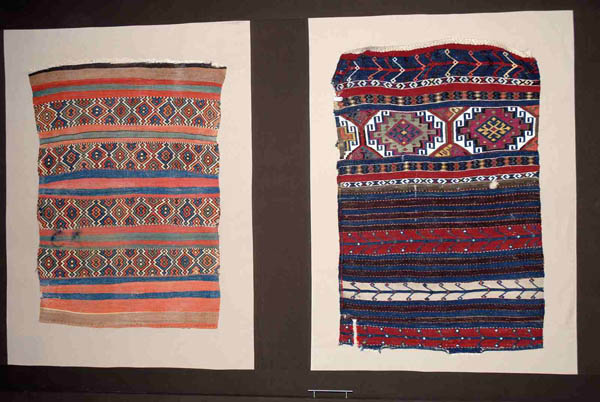
This one is a cicim with a design that was discussed at length
here on Turkotek some time ago.
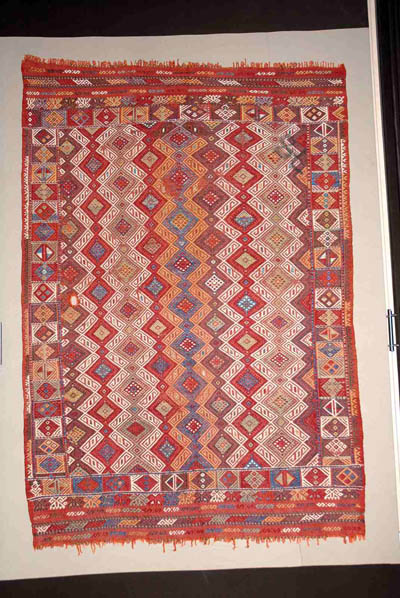
This one is rather unusual, so I
also took a close-up.
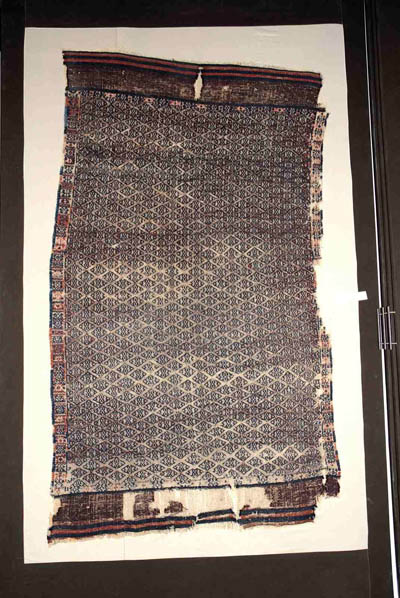
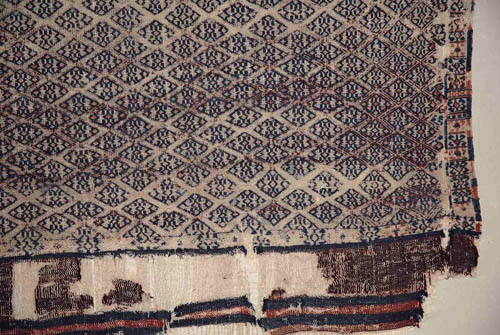
The
central medallion on this piece seems out of scale. It looks sofreh-like, but I
do not know if it had a particular use other than as a rug.
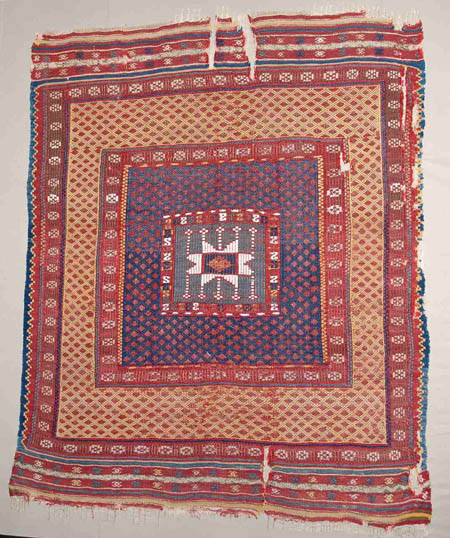
Patrick Weiler
Posted by Wendel Swan on 07-07-2007 10:39 AM:
Hi Pat,
Except for the first one, all seem to be brocade or brocade
and kilim. Do you have a close up of #1 or do you recall its
structure?
Wendel
Posted by Patrick Weiler on 07-07-2007 12:40 PM:
Orange anyone?
Wendel,
That first piece above was slit weave tapestry. I do not have
a close up, but the original photo is quite large - I reduced it in size as much
as my software allows and Steve may have made it even smaller for Turkotek. I
took a close-up look at it and it is definitely slit weave, with some eccentric
wefting and the designs in the white stripes are outlined with black lines so
they stand out well.
Here are a few more from the same museum. The
majority of them have a delightful variety of orange colors which might make
some of us suspicious if seen in a rug at our local rug store. Orange was so
ubiquitous that it was eagerly used when synthetic orange became available,
leaving thousands of rugs in collector limbo.
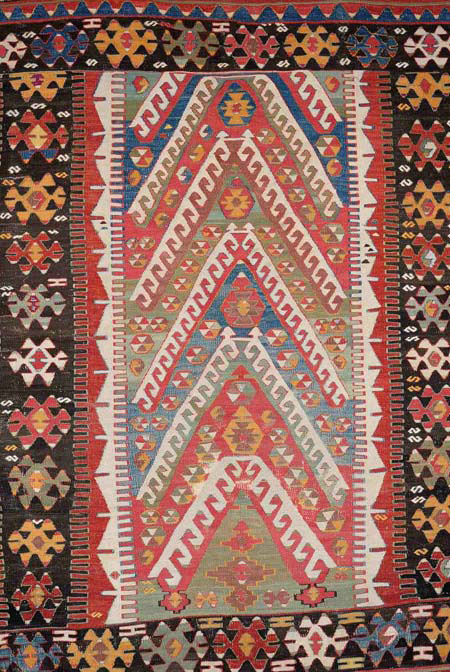
The pink highlights in this
piece are delectable - another color which, in more recent rugs, would cause
concern among collectors.
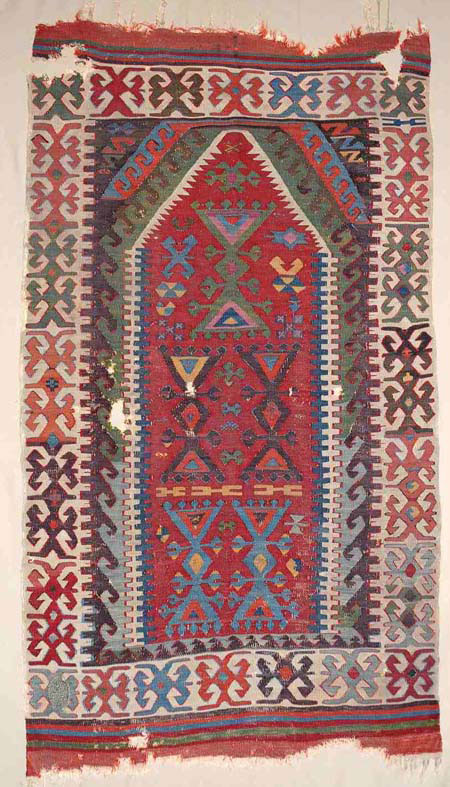
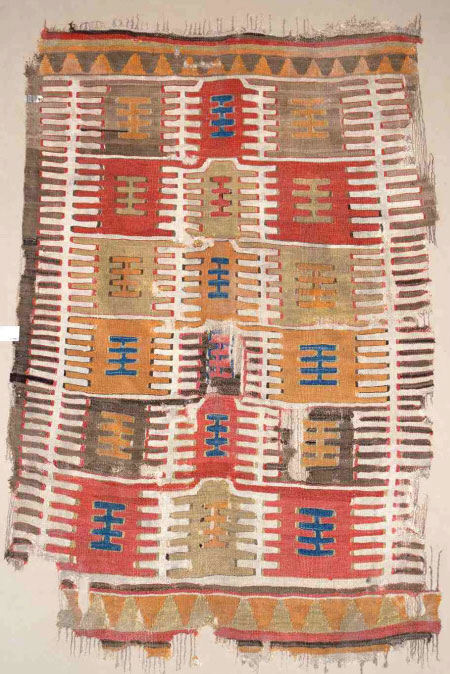
This one has what appears to be cochineal red in the two-legged
rocket ship at the middle of the piece. I wonder if cochineal was used in
combination with other dyes to make an orange color, too.
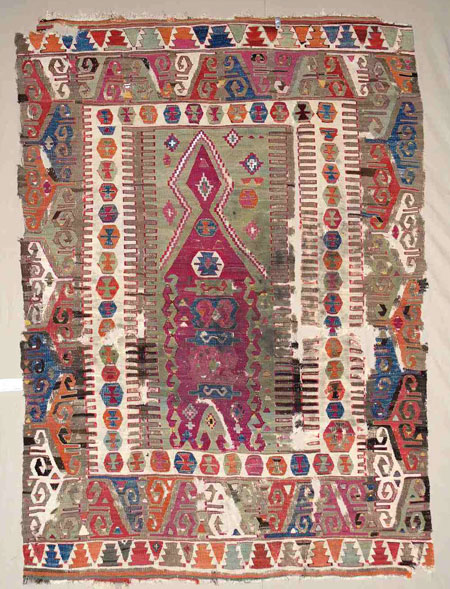
.jpg)
.jpg)
Patrick Weiler
Posted by Unregistered on 07-07-2007 11:50 PM:
Good stuff, Patrick. Having regard to the piece of which you also showed a
close-up, I note that the device in the field is very similar to a common field
design in Baluch pile rugs. Another intriguing connection between Anatolian and
Baluchi weaving, or could that brocade be Baluchi too?
Posted by Steve Price on 07-08-2007 05:44 AM:
Hi
Please overwrite the word unregistered (in the user name
field)with your name when you post.
Thanks
Steve Price
Posted by Rich Larkin on 07-08-2007 09:58 AM:
Hi Steve,
Sorry about that. New computer, I forgot to enter the
registration.
Regards.
Posted by Richard Larkin on 07-08-2007 10:37 AM:
Baluch are people, too
Hey Patrick,
If I had seen that vicious slur aimed at the Baluch in
the other thread (showing the Boteh-Tribe fragment your friend bought), I
wouldn't have brought up the question of the brocade on this thread. There does
seem to be a matrix of designs well known among the Baluch that hearken back to
Anatolian sources, though.
Posted by Patrick Weiler on 07-08-2007 01:17 PM:
Space Case???
Richard,
At first glance at your Unregistered post, I assumed you
wanted to remain an anonymous Balunatic/Baluchophile due to the disregard for
their material in the rug world.

(Are them fighin' words, Dude?  )
)
But no, your true intention was
to indicate a relationship between Baluch designs and others from the rug
weaving world. One might take that relationship another step back to their
shared Turkmen heritage (as described by Jack Williams in a Show and Tell thread
on the Windsor Charlton "?Baluch?" bag face - and to the fact that they live in
the area of the "Silk Road", a veritable alphabet soup of design traditions
stretching from the very farthest East to the edge-of-the-world West during
pre-Columbus days.
And, of course they all originated from Outer Space as
evidenced by the realistic version of a Rocket Ship - as seen in one of the
kilims in this thread - that is the true origin of all "prayer rug" designs -
which pre-date the advent of modern, organized religions by millenia. You
probably did not know that the Caspian Sea was created by a nuclear explosion
from a visiting space ship of just such archaic design, generating the reverence
of the fire-religion in that very area!!

Oh, back to your comment,
can you show us a rug or two with that design in it? It would be interesting to
see how it looks in a Baluch weaving.
Thanks,
Patrick Weiler
Posted by Richard Larkin on 07-09-2007 10:31 AM:
Well, Patrick, I was hoping it wouldn't come to this, but you've forced my
hand, and I now have to expose you as the closet Baluchophile I know you
are. I have strongly suspected it for some time, and my fears were confirmed
when you showed up with that Boteh-Tribe bagface you got at the ICOC. It's
definitely the kind of thing a Baluch maniac would buy when surrounded with rugs
for sale, but none of them were Baluch. And be assured, if I knew how to do it,
I'd have a pair of those litle dueling Johnnies on this page in a
heartbeat.
As far as the brocade design on Baluch pile merchandise is
concerned, I have a little bagface that I will try to post up in a day or two.
I'll give you a cite for another example in Black & Loveless, too, because I
know you must have that volume hidden away somewhere.
BTW, your comments
about the great design melting pot and the Silk Road and all that stuff are OK
as far as they go, but I think the connections between old Baluch designs and
certain Anatolian parallels are too particularized to be explained adequately by
that.
__________________
Rich
Larkin
Posted by R. John Howe on 07-09-2007 12:45 PM:
Hi Rich -
"Particularized?????"
Oh my god, you mean this
Balouch shit is going to infect our discussion of entirely innocent Anatolian
weavings as well?
I just bought a coir rain cape from southwest China.
It is dark colored, but I'm hoping the Balouchies will not follow me
there, Jerry Anderson and his snakes (did he drink?)
included.
Regards,
R. John Howe
Posted by Richard Larkin on 07-09-2007 01:44 PM:
Hi John,
Evidence is what it is. I think your rain cape is safe,
though.
__________________
Rich
Larkin
Posted by R. John Howe on 07-09-2007 02:24 PM:
Hi Rich -
You're right, of course.
I look forward (I think)
both to the particular similarities to be cited and to evidence of direction of
flow. (I think estimated age will disadvantage most of the Balouch material we
have in the broader argument in this latter regard. Are there any published
Balouch pieces with an estimated age before the 18th century?)
Although
there is some revision in process, Anatolian and Mamluk pile weavings have been
seen to offer the older examples. "Persian" examples before the 16th century
still seem rare.
Reconceptualization of existing attributions could
change that.
What would be needed for more recent things would be
evidence of Balouch, or related Khorasan groups, migrating into Turkey (this did
happen) and then the springing up of designs or technical usages, not
traditionally Anatolian, in the areas where they settled (I know of two
Anatolian examples of the latter, but they seem to point to Turkmen weavers and
to Turkmen-like structures not to those of the Balouch).
But it is a
little tiresome to hear (not from you) a constant drumbeat suggesting that
nearly everything turns out to be sourced in Balouch design usages. Even if
there are plausible similarities to be noted, correlation is not causation. I
don't fancy design evolution analysis at all, but if I did my money would be on
most Balouch usages being derivative.
I do feel pretty safe with this
Chinese piece. There isn't any design at all. It's like a shaggy plant-sourced
"bear rug."
Regards,
R. John Howe
Posted by James Blanchard on 07-09-2007 11:16 PM:
Hi John,
Like you, I would prefer a more constrained approach to the
invocation of a Baluch attribution, but perhaps for different reasons than you.
For me, Baluch weavings from a century or more ago have recognizable design and
aesthetic characteristics which are perhaps more particular than some Persian
weaving groups. Adding a bunch of other designs and types seems to be
unnecessary dilution of the Baluch repertoire.
In terms of Baluch
weavings, I personally prefer to characterize their approach as assimilative
rather than derivative. Unlike some other weaving groups that seemed to
incorporate others' designs directly, the Baluch always seemed to put their own
particular spin on things to make the final product fit within a characteristic
aesthetic. As I have mentioned in other threads, I think this might be related
to their particular social structure which is said to be much more conducive to
incorporating other peoples into their tribal organization, but this is a rather
fanciful theory.
Also, I have come to believe that Baluch weaving has a
somewhat longer history than has been suggested by some. Rugs from the mid- to
late 19th century exhibit a very stable and characteristic set of designs,
colours, etc. that are very different from the putative sources of their
designs. For example, early renditions the Baluch mina khani design is quite
different than the Persian versions, and quite stable. To me that suggests that
the origin was perhaps a few or several generations old. Again, this is just
speculation on my part.
Cheers,
James.
Posted by Jack Williams on 07-10-2007 02:46 AM:
No need.
John,
Jeremy Wood Anderson cannot follow anyone, because he is dead,
and yes he drank…copiously. However, the breath of his ideas and knowledge may
now be beginning to be appreciated. I cannot see what effect his profession
(herpetology) or drinking had on the validity of his ideas about rugs or
history…and incidentally, those ideas extended far beyond Baluch. Personally, I
don’t care much for Anatolian weavings. But I haven’t seen the need to worry
about those carpets or the people who find them fascinating. Perhaps I will
learn to appreciate the genre someday.
It wouldn’t hurt to understand a
bit about the origin of any weaving culture, and the difference between a
culture and a political confederacy. It seems to me that Baluch designs remained
open, tribal, nomadic, and individually unique when every Turkmen tribe from the
Bosporus to the Altai Mountains had adopted the Tekke gul
Regardless of
one’s personal preconceptions, unfortunate logic is something we all should
avoid don’t you think?…such as a non sequitur argument. An example, “since we
have not identified any 17th C. Baluch rugs, there weren’t any.” Or,
“because x group uses a boteh, they copied it from someone.” Neither of
those statements can stand scrutiny. In my view, neither can blaming Jerry
Anderson for other people thinking about design development through time.
If I want to look only at the artistic composition of a rug...I'd rather
go to the local college art school fire sale. I've had my say, and will feel no
need to further elaborate. I suspect I've misunderstood the written word. If so,
I apologize.
Regards,
ack Williams
Posted by R. John Howe on 07-10-2007 07:51 AM:
Hi Jack -
Well, since we're talking about it, let's actually talk
about "it."
I have no quarrel with those that admire Balouch weaving.
Wendel Swan once owned a Balouch rug with a mina khani design that I think is
one of the best things of any sort I have ever had in my hands. Steve Price owns
a couple of Balouch pieces that are, in my view, "to kill for."
The
complaint is that if everything has to lead in one or two posts to a conjecture
(and it seems usually to be mostly that, as in your recent effort to connect the
Pazyryk rug) to the Balouch, then conversation here about anything else is
effectively barred.
I think this is the case even if, in some instances,
the suggestion is in jest. The move is one that diverts, sets up tangents, and
basically moves to reshape any conversation so that other things (I suspect that
you will agree that there ARE other things worthy of discussion) cannot
effectively be discussed.
My own suggestion would be that the Balouch
admirers here post threads about their interest, but that they refrain from
derailing other threads that are clearly focused on other interests. Now that
doesn't bar an occasional pointing out of some similarity between some design
and a Baluch usage that is pretty clear. But if everything posted has to come in
a couple of posts to a discussion of the Balouch then its becomes difficult to
discuss anything else.
Some experienced folks make a related complaint in
which I do not fully join them. It is that far too many electrons are expended
here on Turkotek in seemingly endless discussion of rather recent, not
particularly remarkable, Turkmen and Balouch pieces. I do not think that such
conversations are producing anything particularly profound, but I am not one of
those uninterested in more recent material and Turkotek is primarily a forum in
which those interested in rugs are encouraged to share their interests.
I think extended discussion of more recent and rather ordinary material
is not something about which we can complain, except perhaps, unless the
participants think they are doing something more serious than sharing their own
thoughts and enjoyments of such material. And new posters and less experienced
folks get a special license in this regard.
A footnote about Jerry
Anderson. I do not know what part of his assertions are correct. It seems clear
that he spent a lot of time "on the ground" so to speak, in Balouch country. But
I think it does him no service to invoke him in conversations here as if he is
an unanswerable god. He may well have known a great deal, but he did not choose
to share his knowledge in a mode that can be examined and critiqued. I
especially object to insertions of Anderson's sneers at the work of George
O'Bannon, who did repeatedly subject himself to the discipline of moving to
print and who opened himself repeatedly to the potential criticism that can
result from that move.
Anyway, those are my thoughts about this "Balouch"
issue, the related "newer material" issue, and about Mr. Anderson.
Others
may well have different takes.
Regards,
R. John Howe
Posted by Richard Larkin on 07-10-2007 08:33 PM:
Baluch spinoff
Hi John:
I hope with this post to show a small bagface image that uses
in pile a repeating decorative device very similar to the one repeateded in the
brocaded item shown in the fourth and fifth images above.
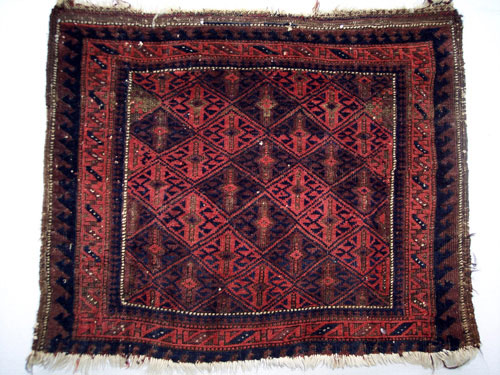
The motif in my piece should
very familiar to anyone conversant with Baluch pile weaving, and there are many
other examples published (several in Black and Loveless, a couple in the 1974
Christmas Exhibition catalog of the Hajji Baba Club, Griffin Lewis [1911],
etc.). I found the similarity remarkable only because I assumed Patrick's images
from the Tokat Vakif museum were of Anatolian brocades. The mystery would be
substantially dispelled should the brocade itself be Baluch, or of some other
provenance much more closely associated with the Baluch. I lack the expertise to
pronounce on that point. If the brocade is in fact Anatolian, I believe pointing
out the connection to be reasonable and within the spirit of the thread.
Referring to your comments, I am intrigued by certain connections I feel
I have observed between Anatolian weaving and Baluch weaving for many years. I
would assume absent compelling evidence to the contrary that the direction of
flow would have been Eastward from Anatolia. The only reason it seems remarkable
is that such a connection doesn't seem very likely, in contrast to the many
other obvious connections between Baluch weaving and Afshar, Turkoman, Kurd,
Southwest Persian tribal, Persian village, etc., etc. I believe the incidents I
have observed to go beyond the mere vague migration of decorative devices, e.
g., the Memling gul. If I had to speculate about the reason for the connection
(I'm reduced to speculation for the most part, being an indifferent scholar), I
would guess at one or more defined ethnic groups steeped in certain Anatolian
weaving traditions having moved, voluntarily or otherwise, into proximity or
alliance with Baluch groups. In any event, I see the question as a real one and
it intrigues me.
Regarding your obvious pique at the bumptiousness of the
average Baluchophile on TurkoTek, I can well imagine it is irritating to have
certain persons (no names mentioned) bleating "Baluch" at every turn. I've
bleated myself a few times, I suppose, maybe too often. Nevertheless, I think
you overstate the case, or the problem (if it's a problem), in terms of such
comments rendering other discussion effectively impossible.
I have a
footnote on Jerry Anderson, too. I think the greatest part of knowledge and/or
lore that is abroad in the land about rugs and their related weavings is a mass
of data (true and false) compiled or generated by people like him, including
dealers and others active in a non-scholarly way in the field. My own
"formation" in the field, apart from hanging about in bazaars, came from
dealers. They had huge amounts of information, but in looking back on things,
every one of them also had bad information. For the most part, they weren't
scholars. It's been the curse and the blessing of the field all through the
years. I don't doubt that Anderson had enormous knowledge about weaving in the
area of his activity and interest, and it won't be recovered by scholars. He
also had some large canards in his repertoire. I can tell that from reading the
comments of my friend, Gene. Nevertheless, I would always want to know what the
likes of a Jerry Anderson had to say about any Baluch rug of merit.
__________________
Rich
Larkin
Posted by Jack Williams on 07-11-2007 01:20 AM:
Baluchify the Pazyryk, or Pazyrykofy the Baluch
John,
We all have long suspected how you feel about Baluch-o-tek
nation...it isn't a surprise. However, this piece about Jerry and the Baluch
seems a little over the top. Re: "It seems clear that he spent a lot of time
"on the ground" so to speak, in Balouch country." None of those numerous
qualifying phrases are necessary. Jerry was born, lived his entire life, and
died there, not insulated within an isolated European community either.
Despite his AADD, alcohol, poverty, and the paltry academic resources
available (where could you find a good library card catalog?), he was sought out
by every collector and researcher who journeyed to the area, and about a lot
more than just rugs.. His voluminous correspondence with McCoy Jones, Boucher,
et. al. running to hundreds of pages could have played a big role in
establishing much conventional wisdom about Afghanistan.
If Gene ever
gets around to writing his remembrances, perhaps it will help understanding the
man, including his wilder flights of ethnography fancy.
But...you
obviously have some issues.. So do I.
(a) Would you care to
expand on your comment, "I especially object to insertions of Anderson's
sneers at the work of George O'Bannon..."?
Just when did Anderson
sneer at George O’Bannon, and in what context? Who is inserting "Anderson's
sneers at Mr. O'Bannon" into their comments? I seem to have missed sneers at
George O’Bannon, but have seen several at Jerry, that I thought were
gratuitous and unnecessary. Yours is one of them. Why? Did something happen
10-20 years ago that we are unaware of? Help me…
(b) This
particular line was not started by you, and the principal posters in this line
were the ones lightheartedly tossing Baluch bombs at each other... What caused
your sudden interjection and then that shot at someone you know little about…
followed by veiled references and innuendos about Baluchsters hyjacking lines?
Reminds me a little of what happened to Lad Duraine. In this line, your Baluch
comments looked diversionary, not everyone else’s.
(c) Like you,
I don't care for some of the newer, street vendor rugs posted here. They often
can’t even lead into sociology because they don’t have much sociology woven into
them. But I also didn't care that much for a lot of the more ragged, marginal
textiles in a flood of posts from Anatolia either. No problem, I looked at them
all, I learned quite a bit, noticed what resonated artistically or
intellectually, and went back to the lines that that I felt I could contribute
to.
(d.) I really would like to know your source of the badam
border and "stacked guls equals Afghanistan” attribution…and what you think
“Afghan” means in a Turkmen rug context? But that’s a question for another line.
My point...sociology is a part of rugs. Many of us like it and study it deeply.
It isn't going away, especially with millions of volumes available on the
internet.
If you wish, you may email me direct if you feel we need to
work something out. By the way, you win the prize for publicly recognizing this
fragment (below). No one else commented, so I thought I had gotton away with
Baluchifying the Pazyryk carpet.... Your powers of observation are pretty good.
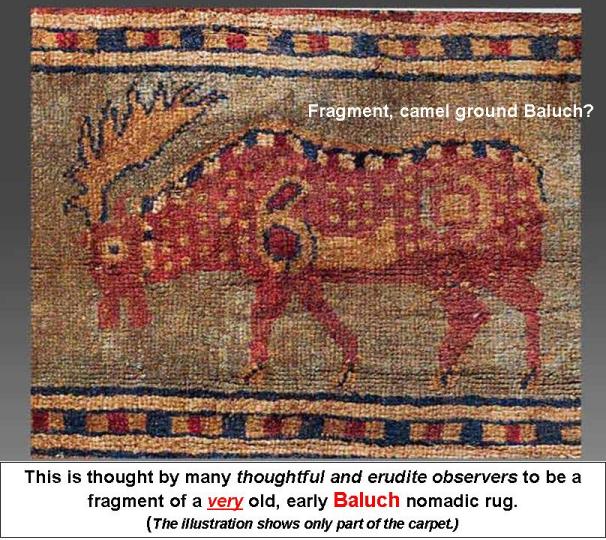
Regards,
Jack
Posted by R. John Howe on 07-11-2007 08:39 AM:
Jack -
I tried to reply off board since our exchange is likely to bore
some on Turkotek, but I got an error message from the aspect of our Turkotek
software that permits us to send emails So I'm posting a response here after
all. My apologies to the bored and especially to Pat Weiler for what I have done
to his thread.
I've copied your last post into this email so that I can
respond to it systematically. I am going to put my responses below entirely in
capital letters to distinguish them, but I am not shouting.
You
began:
We all have long suspected how you feel about Baluch-o-tek
nation...it isn't a surprise.
A SMALL CORRECTION: I AM MYSELF PRIMARILY A
TURKMEN-CENTRAL ASIAN COLLECTOR AND SO AM NOT ADVERSE, INSTINCTIVELY, TO BALOUCH
MATERIAL.
However, this piece about Jerry and the Baluch seems a little
over the top. Re: "It seems clear that he spent a lot of time "on the ground" so
to speak, in Balouch country." None of those numerous qualifying phrases are
necessary. Jerry was born, lived his entire life, and died there, not insulated
within an isolated European community either.
I DO NOT, IN FACT, KNOW
MUCH ABOUT JERRY ANDERSON, EXCEPTING WHAT WAS CONVEYED IN THE TOM COLE INTERVIEW
OF HIM IN HALI A FEW YEARS AGO. I WAS MERELY TRYING TO ACKNOWLEDGE THAT HE
CLEARLY HAD AN EXPERIENTIAL BASIS FOR HIS VIEWS. THE SEEMING QUALIFICATION IS
ONLY A SCHOLARLY AFFECTATION.
Despite his AADD, alcohol, poverty, and the
paltry academic resources available (where could you find a good library card
catalog?), he was sought out by every collector and researcher who journeyed to
the area, and about a lot more than just rugs.. His voluminous correspondence
with McCoy Jones, Boucher, et. al. running to hundreds of pages could have
played a big role in establishing much conventional wisdom about
Afghanistan.
IT DOES SEEM THAT A LOT OF SERIOUS PEOPLE HAVE TREATED
ANDERSON SERIOUSLY. IF THERE ARE "HUNDREDS" OF PAGES OF HIS CORRESPONDENCE WITH
SUCH FOLKS, THE BEST USE OF IT WOULD BE TO GO THROUGH IT AND MAKE THE BEST OF IT
AVAILABLE PUBLICLY. SOME OF THAT COULD BE DONE HERE ON TURKOTEK.
If Gene
ever gets around to writing his remembrances, perhaps it will help understanding
the man, including his wilder flights of ethnography fancy.
I THINK THAT
WOULD BE POTENTIALLY USEFUL, TOO.
But...you obviously have some issues..
So do I.
(a) Would you care to expand on your comment, "I especially
object to insertions of Anderson's sneers at the work of George O'Bannon..."?
Just when did Anderson sneer at George O’Bannon, and in what context?
Who is inserting "Anderson's sneers at Mr. O'Bannon" into their comments? I seem
to have missed sneers at George O’Bannon, but have seen several at Jerry, that I
thought were gratuitous and unnecessary. Yours is one of them. Why? Did
something happen 10-20 years ago that we are unaware of? Help me…
MY
COMMENT AND OBJECTION ARE ROOTED IN A COUPLE OF POSTS GENE MADE IN WHICH HE SAID
"APPROXIMATELY" THAT ANDERSON "LAUGHED" AT INDICATIONS O'BANNON MADE IN HIS BOOK
"THE TURKOMAN CARPET." NOW O'BANNON MADE MISTAKES AND SOME OF HIS WORK IS BEING
CORRECTED BY OTHER SCHOLARS (ANDY HALE, FOR EXAMPLE). BUT I THINK IT A SHADE
IRRESPONSIBLE TO STAND ALONG SIDE A POOL TABLE AND TAKE POTSHOTS AT SOMEONE WHO
HAS TAKEN THE TROUBLE TO PUBLISH. AND I THINK GENE'S POSTING OF SUCH INDICATIONS
ALSO HAS THE EFFECT OF DENIGRATING, WITHOUT MUCH RISKING ONES-SELF, THE WORK OF
A SERIOUS, HONEST MAN.
(b) This particular line was not started by you,
and the principal posters in this line were the ones lightheartedly tossing
Baluch bombs at each other... What caused your sudden interjection and then that
shot at someone you know little about… followed by veiled references and
innuendos about Baluchsters hyjacking lines? Reminds me a little of what
happened to Lad Duraine. In this line, your Baluch comments looked diversionary,
not everyone else’s.
IN TRUTH MY COMMENTS WERE TANGENTIAL, BUT I HAD
BEEN APPALLED BY THE TENDENCY IN OTHER THREADS TO CONTINUALLY DERAIL WHATEVER
WAS BEING DISCUSSED BY TAKING THE CONVERSATION TOWARD THE BALOUCH. WHAT STRUCK
ME WAS THAT THIS WAS SEEMINGLY HAPPENING AGAIN IN A NEW AREA: ANATOLIAN
MATERIAL. NOW I SEE RICH LARKIN AS A SERIOUS, REASONABLE AND KNOWLEDGEABLE
PERSON SO MY OUTBURST WAS NOT DIRECTED AT HIM, ONLY AT THE NOTION THAT ONE MORE
AREA WAS GOING TO BE THE OCCASION FOR CLAIMING BALOUCH SIMILARITIES (AND MAYBE
SOURCES). IT WAS NOT THE BEST PLACE TO MAKE THAT MOVE SINCE THE THREAD IS PAT
WEILER'S AND HE'S TRYING TO SHARE SOME ANATOLIAN PIECES.
(c) Like you, I
don't care for some of the newer, street vendor rugs posted here. They often
can’t even lead into sociology because they don’t have much sociology woven into
them. But I also didn't care that much for a lot of the more ragged, marginal
textiles in a flood of posts from Anatolia either. No problem, I looked at them
all, I learned quite a bit, noticed what resonated artistically or
intellectually, and went back to the lines that that I felt I could contribute
to.
IF YOU READ CLOSELY YOU WILL SEE THAT I HAVE SAID SPECIFICALLY THAT
WE CANNOT REALLY COMPLAIN ABOUT THE TENDENCY TO PUT UP AND DISCUSS BOTH NEWER
AND MORE PEDESTRIAN MATERIAL. WHAT I DID WAS REPORT ON A SECTOR OF EXPERIENCED
COLLECTOR OPINION DOES OBJECT TO THIS. (SOME OF THEM FEEL SO STRONGLY THAT THEY
SAY THAT TURKOTEK IS IN FACT DOING "HARM" TO THE RUG WORLD BY FOSTERING SUCH LOW
LEVEL CONVERSATIONS). SOME ADVISE US TO SHUT THE PLACE DOWN IF WE ARE NOT
WILLING TO ATTEMPT TO ACHIEVE A HIGHER LEVEL OF QUALITY BY RESTRICTING
PARTICIPATION. THE "OWNER/MANAGERS" OF TURKOTEK (OF WHICH I AM ONE) DO NOT SEE
THE SITE IN THAT WAY AND ARE UNWILLING TO RESTRICT PARTICIPATION. LIKE YOU, I
THINK IT IS POSSIBLE TO LEARN AS THE RESULT OF THE DISCUSSION OF MATERIAL THAT
MOST WOULD SAY IS NOT REMARKABLE. SO YOU AND I HAVE NO DEBATE ON THIS POINT AND
MY POST DID NOT INDICATE THAT WE DO.
(d.) I really would like to know
your source of the badam border and "stacked guls equals Afghanistan”
attribution…and what you think “Afghan” means in a Turkmen rug context? But
that’s a question for another line. My point...sociology is a part of rugs. Many
of us like it and study it deeply. It isn't going away, especially with millions
of volumes available on the internet.
AGAIN, IF YOU READ CLOSELY, YOU
WILL SEE THAT I SAID OPENLY THAT I CANNOT PROVE ANYTHING ABOUT THIS "STACKED
GUL" INDICATOR. IT IS ENTIRELY THE RESULT OF MY OWN OBSERVATIONS OVER THE YEARS
WITH REGARD TO PIECES SAID TO BE FROM AFGHANISTAN. I WOULD GO A LITTLE FURTHER.
IF YOU LOOK AT THE IMAGE THAT JAMES PROVIDED, I ALSO THINK THAT THE OUTSIDE
OUTLINE OF THE MAJOR GUL IS ALSO THE SHAPE OFTEN SEEN IN MANY AFGHAN PIECES AND
THE INTERIOR INSTRUMENTATION USING TRIANGLES MAY ALSO BE FREQUENT. BUT I JUST
MADE AN OBSERVATION NOT A CLAIM TO ANYTHING REALLY.
d. If you wish, you
may email me direct if you feel we need to work something out.
WELL, I
THINK YOU SEE MY MAIN ISSUE, ALTHOUGH YOU MAY WELL DISAGREE. THERE IS A TENDENCY
TO THE TANGENTIAL IN LOTS OF THREADS. SOMETIMES THAT CAN ACTUALLY LEAD TO THINGS
THAT ARE MORE INTERESTING THAN THE ROOT THREAD. BUT IN THE CASE OF MY COMPLAINT
MY OWN EXPERIENCE IS THAT YOU AND GENE IN PARTICULAR FREQUENTLY TAKE
CONVERSATIONS THAT ARE ABOUT OTHER THINGS ENTIRELY INTO THIS AREA OF YOUR
PARTICULAR INTEREST. IF EVERYTHING MUST REMIND US OF SOMETHING BALOUCH THEN IT
IS NOT, EFFECTIVELY, POSSIBLE TO HAVE DISCUSSION OF ANYTHING ELSE. MY REQUEST IN
THIS REGARD SEEMS REASONABLE TO ME. JUST STOP DERAILING THREADS ABOUT OTHER
THINGS. IF YOU HAVE A "BALOUCH" INSIGHT TO SHARE (ESPECIALLY IF IT IS A LITTLE
STRAINED) START ANOTHER THREAD.
ONE LAST THING UNRELATED TO ANY OF THE
ABOVE. IT IS CLEAR THAT YOU AND GENE KNOW A LOT ABOUT THE HISTORY AND ETHNOLOGY
OF BALOUCH COUNTRY AND OF CENTRAL ASIA MORE GENERALLY. THAT CAN BE OF REAL
INTEREST AND USE, ESPECIALLY IF IT IS NOT JUST POURED OUT "EN MASS," BUT RELATED
TO THE RUGS.
I HOPE THAT AT LEAST CLARIFIES MY CONCERNS.
MY EMAIL
IS "rjhowe@erols.com"
REGARDS,
R. John Howe
Posted by Richard Larkin on 07-11-2007 01:20 PM:
TurkoTek
Hi John:
I've had my say about the immediate flurry, and I am content
to leave it at that. I would like to comment on one point raised in your
response to Jack, the one about what is appropriate topical material on
TurkoTek. I would agree with some of your offstage critics that there is quite a
bit of (frankly) schlocky material reviewed on TurkoTek, probably beyond its
merit, and sometimes at excessively great length, too. That's just my personal
opinion, and I don't see myself too high on the ladder of "strict standard"
commentators. Nevertheless, it is an occupational hazard for a welcoming, "come
one, come all" venue like TurkoTek. It is preferrable, in my view, to what would
result from a juried review of the potential contributions. Incidentally, with
all due respect to the scholars among us, some of them do tend to take
themselves and their studies too seriously in my opinion. I'm reminded of a
certain ambitious wine emporium of a former day in Cambridge that used to
publish a newsletter purporting to find exotic essences of one kind or another
in their vintages. To their credit, they were accustomed to stating that wine
appreciation was a subject that was impossible to approach with too much
humility. It is an adage that works well in the area of rug connoisseurship,
too.
I would like also to point out the obvious fact that the proprietors
of TurkoTek put in a great deal of effort to make the forum available to us and
workable, a feat that (as we see) isn't always easy, and I appreciate that very
much.
__________________
Rich
Larkin
Posted by R. John Howe on 07-11-2007 02:47 PM:
Rich -
Yes, it is not often recognized with sufficient visibility that
Steve Price and Filiberto Boncompagni put in enormous amounts of time and effort
to make our conversations here possible.
But, as Steve is fond of saying,
that's why they get the big "bucks." And Filiberto is currently on vacation,
drawing the full pay that he gets when he is here.
I also think that a
more "select" group would not necessarily be much of an advance. Many
experienced folks spend a lot of their time sorrowing over the aesthetic
inadequacies of their peers.
As one of Philip Roth's characters,
Portnoy, by name, noted in an utterly different, and not entirely polite
context, the position of some more experienced folks often seems to be "no one
can do it like I can."
Regards,
R. John Howe
Posted by James Blanchard on 07-11-2007 02:52 PM:
Hi John and all,
This is not the first time we have heard strains of
"the discussions on Turkotek are not worthy" from unspecified off-line
experienced collectors and/or experts. The solutions seem rather simple to me.
1) Don't read the threads that are uninteresting or too simplistic for
one's taste and experience.
2) Contribute to more sophisticated
discussions by offering interesting pieces or providing more learned commentary
on threads begun by others.
Since I am still on the steep part of the
learning curve, I can usually find something of interest in most threads. As
someone who still has much to learn, I would also observe that on occasion when
I think there is something of interest at a more advanced level, there is too
often a deafening silence from those who might be able to provide more elevated
commentary. I'll offer a personal example. I am interested in the connection
between the Ersari "serrated" border and the "curled leaf" (in relation to my
"MAD Ersari" carpet that I offered on Show and Tell a few weeks ago). This
didn't capture the imagination of other Turkotekkers. However, I have found some
rich discussion in Turkoman Studies I which makes some interesting connections
between the ashik motif and the curled leaf. Although I think it is relevant and
interesting in relation to the Ersari use of the ashik and the "serrated"
border, I have refrained from re-opening that discussion since it drew limited
interest the first couple of rounds.
As I have said before, I personally
wouldn't object if the more experienced folks set aside a discussion forum to
which only they could contribute, and the rest of us could just read. But the
selection of members for that forum might pose some difficulties for the
managers...
James.
Posted by Richard Larkin on 07-11-2007 03:34 PM:
Hi John,
Kudos to Steve and Filiberto, as you suggest. I meant you
too. I don't have a good handle on who does what, or specifically how much work
is actually required, but your own efforts have been very visible since my
patronage began.
James, I suspect a study of why certain informed persons
steer clear of these pages would disclose concerns about professional or
semi-professional reputations. I don't mean to be invidious, and I'm not in
their shoes, but that factor would probably be present.
__________________
Rich
Larkin
Posted by Patrick Weiler on 07-12-2007 01:43 AM:
I do not mind having this thread "hijacked" by Balunatics. Or any other
"tics" or "teks" either.
Some of my best friends are afflicted by that
particular madness. The posters to this web site are not necessarily a
cross-section of the collecting community, but it is refreshing to have a Baluch
contingent that is vocal and contributing.
One of the more satisfying aspects
of Turkotek is that it is a venue for discussing rugs and ethnographic textiles,
any and all. Where else can one participate in an ongoing stream of rug related
conversations with like-minded fellows? I do think one of the shortcomings here
is the tendency to sometimes not tell someone that their prized possession is of
very little collectable merit. (mine included) This does not mean, though, that
a trifling piece has no relevance or connection to other weavings. As someone
once said, every expert was a novice at one time.
Speaking of experts, I have
been told by some that they "look in" on Turkotek, but do not comment. Some are
dealers and feel it would be inappropriate. Others have nothing but disdain for
the level of discourse. Many people, I suppose, tune in for the information (and
the fireworks) but feel no urge to participate.
The price of admission is the
same for everyone and you are not required to participate.
I have a Baluch
piece that has a design that is quite similar to the one Richard posted and it
will be stimulating to see how tenuous the connection is between Turkish and
Baluch designs. I will have to take it off the wall and photograph it in the
next day or so.
Stay tuned and Keep On Posting!
Patrick Weiler
Posted by Gene Williams on 07-12-2007 01:44 PM:
Buy you guys a Beer?
Hi all,
I just tuned in to find the usual food fight over pin-sized
angles.
Couple of things. I feel the History of E.Persian, S.Asian
carpets from Samerkand to Kerman cannot be understood without some understanding
of the tribal areas of Khurrasan. I don't think Khurrasan in turn can be
understood without taking into account Turkoman, Baluch, Timuri, Chahar Aimaq,
Hazara, E.Kurd, Arabic and Pashtun weavings (Mushwani) in the area.
I
don't venture much into commenting on the world of Caucasian or Turkish
carpets..never collected them although I have a few examples of both...so I
usually let the people who know about the subject comment and I admit I
thoroughly enjoy picking up some knowledge from them. (The only comment I think
I've made on that area was the bit about Solar-lundar Calendar and the date on
Jack's rug last year..and that was because I was working with several Persian -
Farsi speakers). Anyway, I was always of the opinion that if you don't know a
lot, listen...and that's not bad advice for the people who don't like the
Eastern border of Iran too.
Gene
PS. As for Jerry Anderson, He's
dead; I'll write his obiturary for "HALI" not Turkotek at some point. But since
he has been mentioned, here are a couple of observations (in addition to what I
said to David Hunt last year):
Jerry Anderson is not a God...but he was
an extremely interesting man and on most points of ethnography, rugdom, history
of the W-Iran, E-Afghanistan area, very knowledgeable..but not infalliable.
Jerry, as I've said many times, was brilliant and he was possibly unstable. And
John, yes he did drink when he had access to it. just as you do.. I've mentioned
this several times in a humorous fashion.
And, Jerry was not, as has
sometimes portrayed, the country bumpkin cousin, diamond in the rough, pure
ruggie, going his way without knowing what was happening in rugdom. Nope, he
knew what was going on in rug scholarship...He introduced me to the Haji Baba
society in 1976..I bought my first book ..Schulman's because he had a copy....
He had some very controversial ideas. He had some brilliant insights.
And like O'Bannon, he was wrong at times...as I've discovered wandering around
Afghanistan. He sometimes accepted "tribal word." And his house was always
filled up with tribals. He was incapable of the discipline of writing a book,
although we talked of it many times. But he wrote litterally hundreds of pages
of observations and some wild speculations about designs and ethnography in
private letters to Boucher and McCoy-Jones and others. It would be interesting
to know if these are preserved in Boucher's estate. It'd also be interesting to
know if one of my best friends (owner of a couple of those exquisite Baluch
Jahan Baig's from David Black's book), in whose home Jerry lived for 18 months,
still has his stuff.
In any event, why don't we all take a deep breath.
Baluch and E.Iranian rugs are interesting and are here to stay, even if they are
banned from Turkotek. and if that's not your cup of tea..don't read the
stuff.
And...since I'm mentioned in the comments above, In my defense, I
never uttered the word "Baluch" in this thread...in fact I didn't even post on
this thread until now, although I'll admit to thoroughly enjoying the
light-hearted exchage between Rich and Patrick. So I think casting aspersions on
me is unfair in some ways (ok, I'm a big boy..life isn't fair.. and I can take
care of myself)
PPS:
John: Buy you a beer..or better yet an
Islay...when I get home.
Patrick: nice bag..and come to think of it, it
does have echos of Baluch..and how that translates down the "Turkish tribal
corridor" (Kurd-Luri-Khamseh-Afshar-Baluch) from Anatolia to Seistan is worth
considering.
James: I said several times your MAD Ersari is
outstanding...don't know enough to comment on it but would like to hear what
you've come up with...there are not a lot of people really researching their
rugs (although I can think of a couple). I'm pretty amazed that a high-quality
rug like that hasn't attracted the attention and high-powered observations of
all the sophisticated experts mentioned above (who are evidently somehow
embarrased by uninformed comments on Baluch rugs..or maybe by Baluch rugs in
general).
Richard: Nice obsevation and comment on the bag...and your
comment and diplomacy increase my respect for your opinion.
Posted by Steve Price on 07-12-2007 02:08 PM:
Hi Gene
You wrote,
Baluch and E.Iranian rugs are interesting
and are here to stay, even if they are banned from Turkotek ...
Belouch and East Persian rugs are banned from Turkotek? Why am I always
the last to know?

Steve Price
Posted by Patrick Weiler on 07-12-2007 08:33 PM:
Anatolibaluchian
OK Steve, since Baluch rugs are now banned, here are some photos of an
Anatolibaluchian rug I have had for quite some time.
It could charitably be
called a "study rug", but I haven't spent much time studying it. I just know I
haven't seen any quite like this one. The major "gul" design is somewhat
superficially similar to the one on the bag that Richard posted.

It has a row of "mountains"
along the bottom of the field, as though the weaver wasn't quite sure what the
design would look like. And that feature carries on throughout the piece - like
a jigsaw puzzle where all the pieces just don't fit together very well. You may
be able to make out one of the flatweave stripes at the bottom is that good,
nearly edible apricot color found in older pieces.

The pile is asymmetric, open left,
7h x 9v with two wefts. There are a couple of "ponds" at the top of the field
with ?waterfowl? floating about. Or are they legless quadrupeds?

It has that typical "electric
blue" that is sometimes seen in Baluch (oops, I mean Anatolibaluchian)
rugs.


It certainly has what one might call
"condition issues" making the central part of the design nearly unreadable, but
the overall impact is one of bold whimsy. The dark colors give it a brooding,
mysterious air.

There are many "dice" scattered about, including two of the
minor borders.
It has 4-cord selvages with goat-hair wrapping.
I could not
say if this design has Anatiolian origins, but it does make an appearance in a
lot of Anatolibaluchian pieces.
Patrick Weiler
Posted by James Blanchard on 07-13-2007 12:41 AM:
Patrick,
I agree with you that your rug has a lot of "Baluch type"
features, and I like it. If I were to mention a particular feature I have
noticed in a large segment of Baluch type weavings it is the use of a generally
low-range palette that is brought to life by a few colour highlights. In your
rug, this effect is seen in the use of the "electric blue" in the border and a
few of the field design elements. My overall impression is that your rug was
woven by someone not fully familiar or practiced with this design repertoire. I
think the main border is meant to be one that is seen on many Sistan weavings
(various colours of diagnonal stripes with internal squares), and also in some
S. Persian rugs. She also struggles with the execution of the "double rams horn
cross" design in many places.
Gene, I appreciated the compliments that
you and others provided regarding my MAD Ersari rug, and I don't want to sound
petty about this. What surprised me a little was that there didn't seem much
interest in further discussing the design origins etc. Perhaps there isn't much
to say, but I have been able to follow up on Steve's reference to the ashik
design, which I think was right on the button and perhaps of some relevance to
an important design pool for some of these Ersari
weavings.
Cheers,
James.
Posted by Richard Larkin on 07-13-2007 02:47 AM:
Folks,
I'm glad Patrick (not me!) put this one up on his own thread,
because it seems in effect to be doing just what John decried: hijacking the
thread with Baluch speculations/ejaculations, or whatever. I don't see the rug
as a particularly compelling example of fairly direct Anatolian influence in
Baluch production. I think the comparison of the brocade I cited and the pile
bag I posted does call up a direct connection that seems to beg an explanation.
Tom Cole's website contains an article in which he suggests one based on
relatively early movement of Seljuk people. He doesn't show the device I've
cited, to my recollection, but I find the article fascinating. This is the
link:
http://www.tcoletribalrugs.com/article60IcocBaluch.html
As
far as my post is concerned, I'd like someone who has the knowledge to comment
on whether the brocade in the Tokat Vakif museum is in fact Anatolian work. If
so, I'm quite amazed, especially inasmuch as the motif has migrated from one
kind of textile to another that is technically very different.
About
Patrick's Anatolibaluchian, I agree with James that the weaver tried to play
with the principal device with mixed results. It came out wonky, see other
thread on Jaf bags! But I like it.
__________________
Rich
Larkin
Posted by Gene Williams on 07-13-2007 01:37 PM:
Patrick's rug and Jerry-O'bannon
Patrick,
I'm very much taken with that Anatoliabaluch rug..the
simplicity, colors, mountains, ducks (dragon boats?)..and the hint of the MAD
Ersari in the borders...And I can't say anything about it worth saying. The
Kelim ends look both Turkoman and Afshar...the pallet has that Baluch look as
James pointed out...and it resonates.. (ok I said something). Rich concentrates
on the brocade and so I immediately go off..kind of like "Life of Brian".."the
brocade..the brocade." But I wouldn't mind seeing the back and
borders.
-------------
Now, this is the last word on John's
complaint about me because it looks like he's defending his friend O'Bannon..a
very worthwhile endeavor and honorable too. The only time I ever/ever heard
Jerry discuss O'Bannon was JA's commentary on passages in "The Turkoman Carpet."
(and Jerry had neither been drinking, nor playing pool that day). O'Bannon
apparently had written about the Kizil Ayak...he decided that they didn't exist
and instead should be called the "Char Shango." Jerry's points were exactly as
those made to me 32 years later by an old Herat dealer.
--- "Kizil Ayak"
is Turkish for "red foot" - and probably is a trade name.
--- "Char Shango"
is Dari/Farsi/Persian for 4 corners - a village in N. Afghanistan exists by that
name..but there is no "tribe" by that name.
Jerry's point was this. Did
O'Bannon speak Dari or Turkish? Or did he take the word of happily nodding
locals when he published that book? If so, who were his guides? Tadjiks or Turks
or Pashtuns? Jerry thought the scholarship was suspect and said so.
Now...John...That is it the absolute totality of what JA had so say
about O'Bannon. Question for you...based on the above, are you now willing to
stand up and declare on Turkotek that Kizil Ayak carpets for now and evermore
should be called "Char Shango" as George did in print?
I've said on
several occasions that among very many other conversations I had with him, JA's
comments on this book and on Kizil Ayak ..he had the book in his hand... stuck
with me. I have made a lot inquiries in the field to try to follow-up on this
with mixed results as I've mentioned a couple of times on Kizil ayak threads.
The last time I checked in Spring 2007, the oldest dealer in Herat said (Afghan
style), "the two (Kizil Ayak and Char Shango) are the same..and well they are
different." He implied that the carpets came from the Char shango village area
but the weave and knotting of Kizil Ayak was different from "Char shango"...i.e.
the fabrics are different. Why was not expressed..I asked the question; didn't
get an answer...and I had the distinct feeling he was searching my face and
asking, "what do you want to hear?" And...I'll try to clarify this when I get
back out there.
I hope this assuages your feeling that JA had it in for
the scholar O'Bannon...quite the contrary...JA was a skeptic as one should be
skeptical in that area of the world...and (maybe this is an unnecessary comment
but one I've discovered is apt and one young rug collectors need to take into
account)..as found out early on (visit to London, Fall 1978 - David Black, Clive
Loveless..and a dozen others) one needs to be skeptical about all/all rug
"experts," including those who would presumably form with John an elite "brain
trust" for this site. In the end, you get captured by the hobby, you do your own
research and you decide which guru you trust.
Gene
Posted by Jack Williams on 07-13-2007 02:10 PM:
Whatever.
Hi ya'll, hows ya mama and all dem?
Oh…To heck with those that don’t
want to participate. I don't think "defending" was the core issue. Whatever. For
some reason, that "Duckpondia" tribal rug (possibly akin to Marty's Afshar)
reminds me of a carpet discussed in “from the horses mouth,” that was a real
puzzler. It was thought by Jerry Anderson to be Rukshani Baluch.
See: http://www.tcoletribalrugs.com/article10JA.html
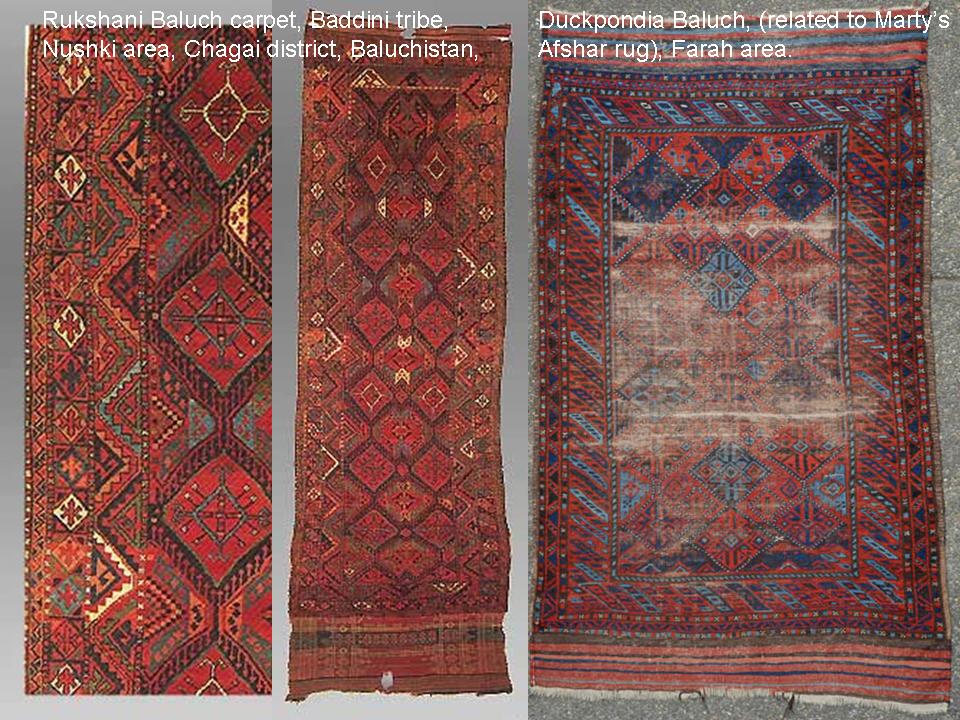
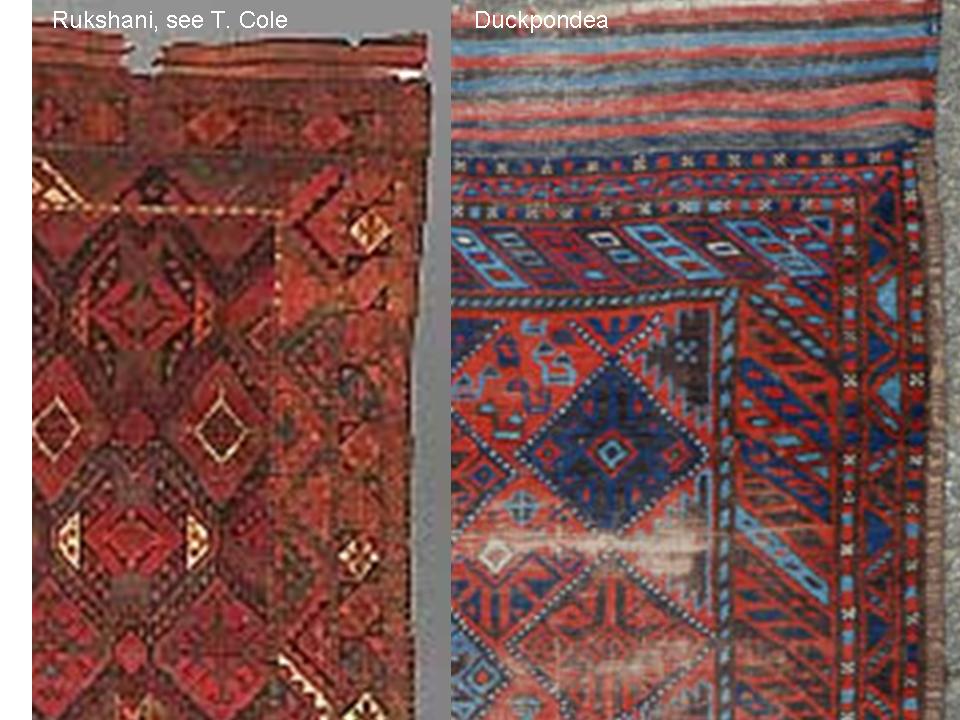
'25. Rukshani Baluch
carpet, Baddini tribe, Nushki area, Chagai district, Baluchistan, late 18th or
19th century. 1.45 x 4.65m (4'9" x 15'3"). Warp: Z2S, ivory wool; weft: brown,
grey brown and apricot wool, 2 shoots; knot: 2ZS, wool, AS open left, 6-7H x
6-9V = 36-63/in2 (558-976/dm2); sides: not original; ends: bands of weft-faced
plainweave, with weft substitution decoration at bottom; colours: 20. Eiland,
Oriental Rugs from Pacific Collections, pl.97, attributed as “Aimaq or Baluchi,
mid-18th century”, subsequently reassigned to “Taimani Aimaq, Khiva, with one
flatwoven end done in Baluchistan”. Anne Halley Collection, Courtesy Adraskand
Inc., San Anselmo, California.'
The ability of Caucasus designs to
get to Baluchdom could have a rreasonable explanation…one that I’ve been looking
into a little. As we know, the Persian armed forces from Shah Ismail to Shah
Abbas were the Kizil Bash Shia Turkmen tribsmen from Azerbaijan, the Afshar
being the most famous. Many of the Aimaq tribes including the Bahluli, are
thought to be possibly Kizil Bash leftovers…and the Kizil Bash were strong
behind the scenes players in Afgan politics at least until the 20th C.
Regards, Jack
Posted by Gene Williams on 07-13-2007 02:37 PM:
Reconsider
Jack,
Nice posts and carpets. And a couple of your historical points
don't fit. KizilBash..red hats (they wore a 12 ponted red hat symbolizing the 12
- Shi'a - Imams)..were essentially Sufi who became Shi'a..who came out of
Azerbaijan with Shah Ismail to conquer Persia..late 1400's, early 1500's with
Shah Tamasb. The Kizilbash were not a tribe but a union of tribes. Their major
battles early on were with the Ottoman in Iraq and Turkey borders. They fought
the Uzbeks in e. Iran about 1520 on... Later on..much later into the 1800's the
Sunni Turkoman tribes were calling all Persians "Kizilbash" to justify their
slaving raids.
So, that puts the Kizilbasn tribal armies down into the
Seistan basin about 1520. The problem is Babur was writing about the Chahar
Aimaqs in 1495..he fought battles with them...and their history takes them back
to the Mongol invasions about 1240.
So, there is no way that the Chahar
Aimaqs...a Sunni group..are related to the Kizilbash tribal groupings around
Shah Ismail who penetrated into Khurrasan in the early 1500's...except that all
claimed Turkish origin. The Chahar Aimaqs were already in their mountain
redoubts as were the Timuris (another Turkish group) incidentally by the time
the Kizilbash Persian/turks arrived in the area.
But..as we discussed
many times..the whole area from the Sinjiang basin of Khotan, Yarkhand etc. to
Anatolia and on over to Algeria and down to Delhi was more or less Turk for
1,000 years...Seljuk, Black Sheep, White sheep, Mahumud of Ghazni, Kizilbash,
Ottoman, Timur, Moguls.... whatever... And they all wove similar designs to some
extent... and these designs are possibly related to earlier Indo-European tribal
group designs inherited from the Sythians (Roman area Indo-Europeans who adapted
to the Stepp life.. i.e. he Sakas..Seistanis...or the Yueh Chi..the blue-eye
Indo European defeated by the Han Dynasty Chinese who recoiled onto Central
Asia...say about the 1st century BC?)
Kizilbash as Shi'a have not play a
role in Afghan politics in any recent
memory...Kabul/Seistan/Kandahar/Baluchistan always was the fracture zone forever
almost between Persia and India going back to Cyrus...and from Mahmud of Gahzni
on, India was Sunni...but Afghans..Kabulis always were Sunni...never Shi'a to my
knowleged..except the Hazara..and they are distinct to this day in Afghanistan.
No Kizilbash tribe played a recent role in Afghan politics.
leave it to
Rich to comment on the Baluchness of Patrick's striking AnatoliaBaluch
carpet.
Gene
Ps. James, I hate to say it but the "experts" don't
seem to be able to contribute much about your oustanding MAD ersari. (John..love
to hear someing interesting from you about that carpet). To me there's a lot of
history there..and I'd like to hear what you have come up with.
Actually, its devilishly difficult to comment intelligently on it
because it seems so familiar but not familair; you can't just generalize...the
structure, provinence and colors seem known, its the design which is
fascinating..but the design is known..they way its put together is what is
unusual. But of course, anything I'd say on the history/ethonology of the area
would have to be cleared with the new self-declared censors..the new "brain
trust" of the site.. who have now decided that Turkotek has become "trite"
because of all the unwashed.. So I'm being careful before writing my opinons
about tribes and movements in the area where I think your rug might have been
made.
Posted by Patrick Weiler on 07-13-2007 07:25 PM:
Dang
Gene,
Darn, I was hoping for a taxonomic identification of my rug.
Common Name: Baluch
Kingdom: Textile
Phylum: Weaving
Class:
Tribal
Order: Pile
Family: Rug
Genus: Dozar
Species: Timuri (or
whatever you think it is)
The link between the design that Richard
showed, a diamond lozenge with a central diamond on a vertical pole and at
either side a sideways "W" and a "C", compared to the museum piece that shows an
8-pointed star with a diamond at the center, a diamond at each apex and a
diamond lozenge outline, is not as strong as it may need to be to show a
relationship other than the basic shape. That does not preclude intermediary
versions, though. And with Gene arguing for a Turkic origin of most of the
peoples of the area from over a thousand years ago - with their related ethnic
design pool - the similarities are not at all surprising.
Tom Cole noted the
Baluch came from an Indo-European Scythian background that was assimilated into
the Turko-Mongolian hordes, but he does not compare Scythian designs with Baluch
designs - he compares some specific Seljuk designs with more recent Baluch
designs - thereby showing a design relationship between the more Indo-European
Baluch group and the Turkmen Seljuk group. He noted that the Seljuks conquered
the Khorasan area of the current Baluch tribes. This would have brought the
Turkmen/Seljuk designs into contact with the Baluch peoples. His picture #9
shows a Seljuk rug with an 8-pointed star within a diamond - similar to the
design of the subject museum brocade rug - but again a bit removed from the one
Richard shows.
By the way, I believe these rugs are from the Ankara
museum, not Tokat. My photos were mixed up when transferred to a laptop, so
Richard, if you are on your way to Tokat, you might want to stop in Ankara on
your way.
And I believe that this brocade rug was Anatolian. I would have
been surprised if it was labeled otherwise.
Patrick Weiler
Posted by Patrick Weiler on 07-14-2007 12:32 AM:
More Rugs
To continue the original pre-Baluch theme of this thread, here are some more
rugs/kilims from the Ankara museum.
This one has an interesting version
of the niche-column design, with different top and bottom borders:
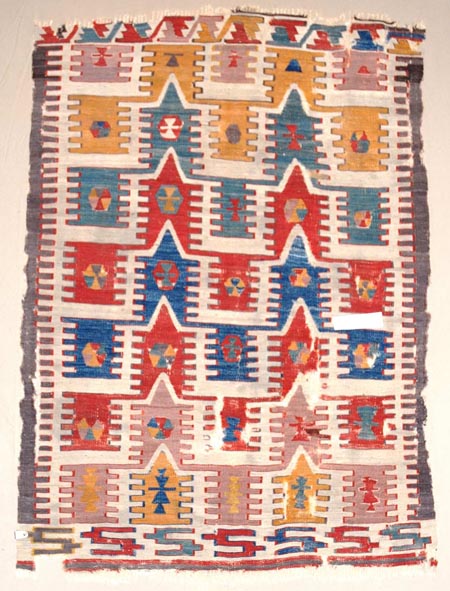
Another pre-historic
rocket ship:
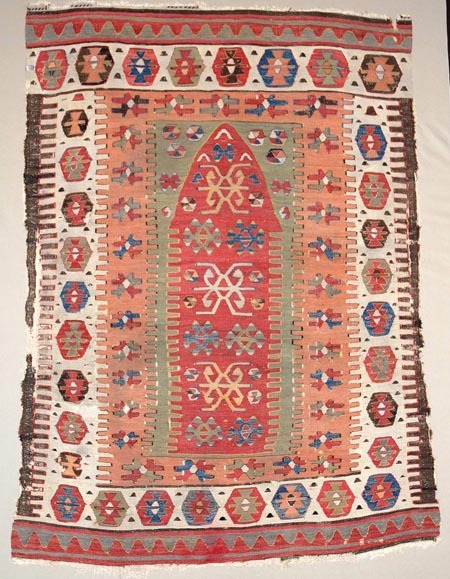
This is a bit odd, with the top border of a different design,
smaller in size than the bottom border and without the reciprocal minor design
at the bottom of the field.
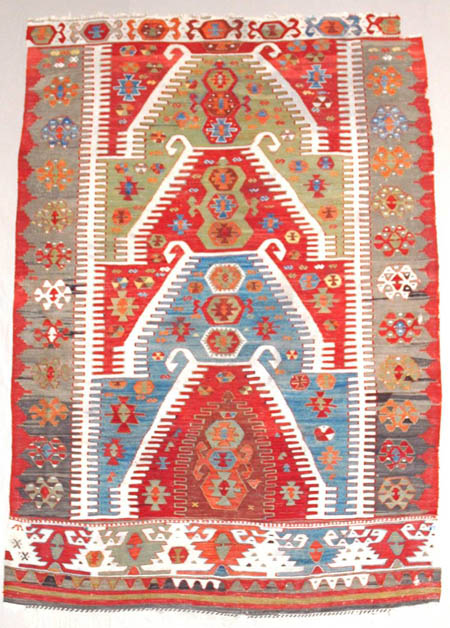
Yes, there were some pile rugs, too! Note the 8-pointed stars
and diamond designs, found not only in the brocade rug but also in the Jaf Kurd
rugs being shown on the Show and Tell.
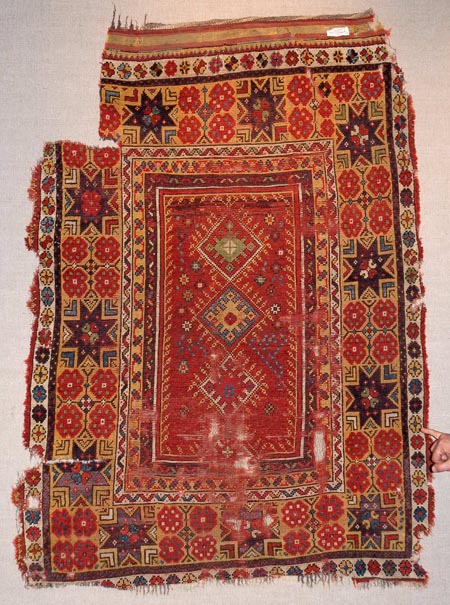
And speaking of the
Baluch/Anatolian connection, the border in this piece is familiar.
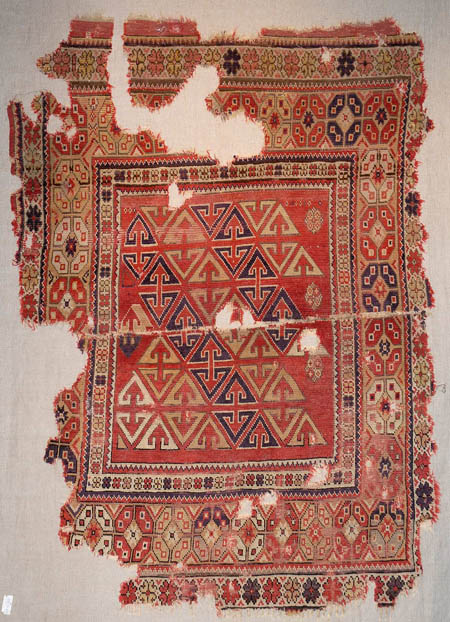
Finally, here is Vedat
Karadagh, our tour leader, ICOC dealer, raconteur, bon vivant and all around
great guy, pointing out that this is not a Baluch rug.
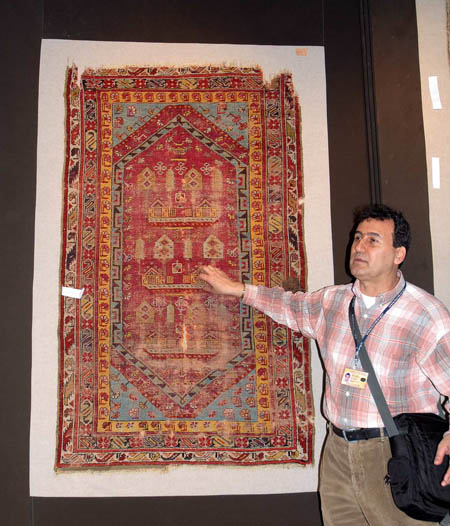
Patrick Weiler
Posted by Richard Larkin on 07-14-2007 11:30 AM:
Hi Patrick:
I'll take your word for it out of respect for your
position as thread leader, but judging from the set of the jaw and the overall
body language, I would swear the guy was commenting on the close resemblance of
that rug to the lighter brighter color palette Tom Cole likes to talk about from
another well known rug producing region. I will not, however, believe that a rug
tour guide could have the name, "Vedat Karadagh," as a real name. But if "Marion
Morrison" could become "John Wayne," I will not begrudge this man his
prerogative.
Speaking of light/bright, the cascade of images in this
thread and many others put up by you and John from the ICOC has been such a
pleasure. The overall effect on me has been to emphasize that the full body of
extant Anatolian weavings is far more varied, interesting and exciting than one
would think if one focused on the limited range of types the older (and not so
older) survey books used to trot out.
Thanks for commenting on my post
relating to an asserted connection between the design device on the brocade and
the well known Baluch device. I was aware of and considered the detail
discrepancies between them, and it may well be that the resemblance is
superficial and accidental. I intend to study the several examples of the recent
incarnation (my own and published) to see what I think about the range of
variation among them, and then compare with the brocade. Keep in mind, I'm no
Walter Denny, and I'm not really trying to prove this particular connection. My
larger point is that I am (and have been for a long time) impressed with the
kinds of parallels Cole attempts to point out in his article between old
Anatolian and more recent NE Persian tribal. As I mentioned in an earlier note,
I find more there than just the general melange of designs and styles all over
those areas.
I agree with your view of Cole's article, that he sees an
infusion of Seljuk influence into whatever the greater Khorrassan context was at
the time. Beyond that, I am unable to make out very much in terms of rugs woven
there within the last 150 years based on one horde after another having moved to
and fro. As we know, the term "Baluch" as a description of all of the weaving is
an inadequate one of convenience and not an accurate statement of the ethnic
origins of the many weavers. But it has been said by some that those weavers,
whoever they were/are, were essentially copyists without a very deep or solid
weaving tradition of their own. I think an implication of what Cole is pointing
out is that there is an ancient weaving tradition in the area and among the
indigenous peoples, who include the descendants of any Seljuks or others that
might have come in a thousand years ago or so. They need defer to no one as
weavers of this sort of textile in my opinion. I agree with James Blanchard's
comment of several days ago (I can't recall just where right now) that this
tradition is characterized by a capacity to assimilate many designs and styles
and make them part of the tradition. This is a strength, not a weakness.
Regarding your entry with the ducks or whatever they are, would you
count the number of rows of knots vertically on the warp lines in one of those
diamonds from tip to tip, and then do the same along the weft line? I'm
interested in the sucessful squares (tipped on point) achieved on that rug, in
contrast to the lozenge effect on my bag. I plan to do the count on mine, too. I
assume that mine has become lozenge shaped due to gradual compression of weaving
along the vertical line relative to the horizontal. Of course, that factor would
not be in play on a brocade, unless the brocadist were simply copying a pattern.
__________________
Rich
Larkin
Posted by Unregistered on 07-14-2007 01:24 PM:
One could also perhaps see a certain connection to the Talish with regard to
the above posted Milas.
Posted by Patrick Weiler on 07-14-2007 01:24 PM:
Square, Man
Richard,
Can't you read Vedat's name badge in the picture?
The
average knot count is 8x8 per square inch and I counted 61 knots top to bottom
and 61 side to side in one of the diamonds. The texture is quite fine and, as
they say, like a handkerchief. Some rows of knots appear to have been beaten
harder and are more compressed, but the wefts make up for the little difference
that the height of the knots causes.
Luckily I had not put the rug back up on
the wall yet.
As for the Anatolian rugs and their variety, many of the
designs never travelled beyond the area they were made in - sort of dead-end
designs. But many others travelled widely, ending up both east and west, north
and south of the weaving world. The broad borders are not frequently encountered
elsewhere and the field design of the next-to-last rug is kinda funny lookin'.
The brocade pattern would not need to be that shape due to compression so it
is either an original design of that shape or, counter to some cases, the design
was transferred from a pile medium with compression.
Oh, and I have never
been addressed as a Thread Leader before. That one is going on my
resume!

Patrick Weiler
Posted by Steve Price on 07-14-2007 01:32 PM:
quote:
Originally posted by Unregistered
One could also perhaps see a
certain connection to the Talish with regard to the above posted Milas.
Hi
Please, when you post, overwrite the word
"unregistered" in the user name field with your name.
Thanks
Steve
Price
Posted by Gene Williams on 07-14-2007 04:36 PM:
8 pointed Star
Patrick,
I suppose its hopeless...a disease of some sort..I need
help:
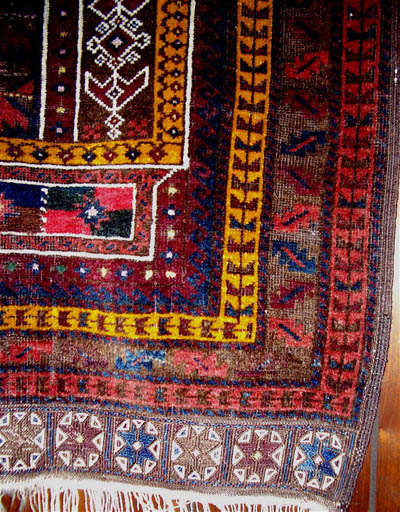
Gene
Posted by Richard Larkin on 07-14-2007 04:55 PM:
Patrick:
BTW, if there's an eight-pointed star in that brocade motif,
I'm missing it. Can you help me. (I know what you're thinking..."That explains a
lot!")
__________________
Rich
Larkin
Posted by Patrick Weiler on 07-16-2007 08:00 PM:
More Rugs, More Stars
This first photo is of an antique tractor outside a store in Ankara, near the
museum at the top of the hill. You can make out the city in the valley below.
This neighborhood had restaurants, dry goods stores and a street or two of
antique dealers. We did not have enough time to explore everything, but due to
the placement of this photo near this batch of rugs it indicates that they were
at the Ankara museum.
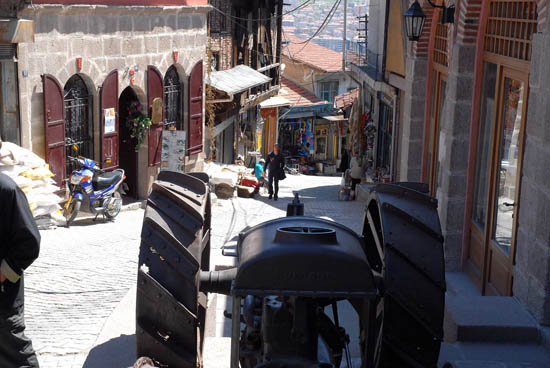
Richard,
First you could not read Vedat's name badge and now
you can't see the stars in the brocade. Am I detecting a trend?
Actually, I
had to blow up the close-up on my own monitor to decipher the design on the
brocade. Most of the red has corroded away, leaving mostly blue and white,
making it difficult to discern the design.
The 8-pointed star looks like some
of those in this first rug. In the top row of stars, the first one on the left,
and the fifth and sixth have the same design that is inside the diamond motif on
the brocade. In the second row from the top, all but star one and five have the
same design. This rug also has that Baluch-looking border.
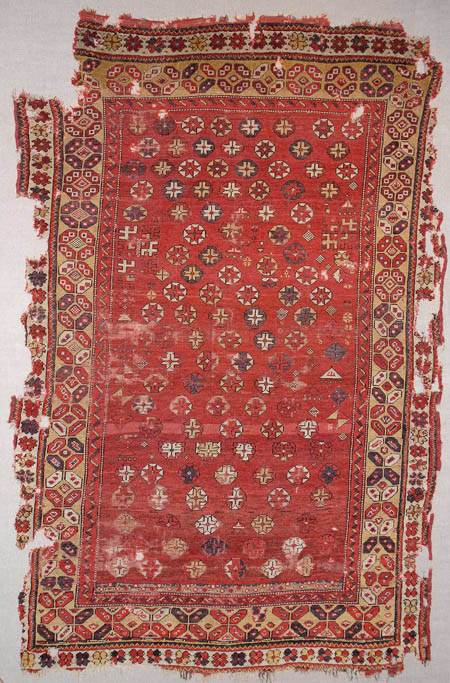
This next piece illustrates a
speculation I have made on Turkotek before, but I never had an example to
confirm it. The major border is what devolved into the Kazak wine-glass and leaf
border. You can readily see that if this major border is cut in half you have
the leaf part and with the middle diamond cut in half it acquired a line that
transformed it from half a diamond into an upside-down triangle with a stem - or
wine glass.
Some of the round flowers in the field contain 8-pointed stars,
too:

Next we
see a Western Anatolian piece reminiscent of modern Bergama pieces, but with a
few old designs in the field, such as the Memling gul and those curious
bird-like creatures I do not recall seeing before, and the central gul has that
pesky 8-pointed star:
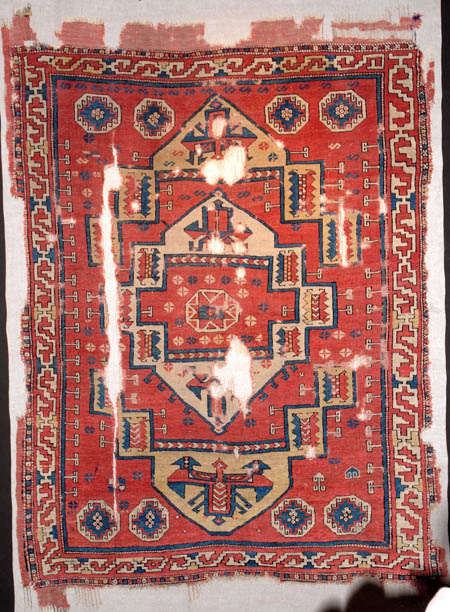
Next, an Eastern Anatolian Kurdish divan cover perhaps. Note
the 8-pointed stars in the rows between the major Holbein-gul rows:
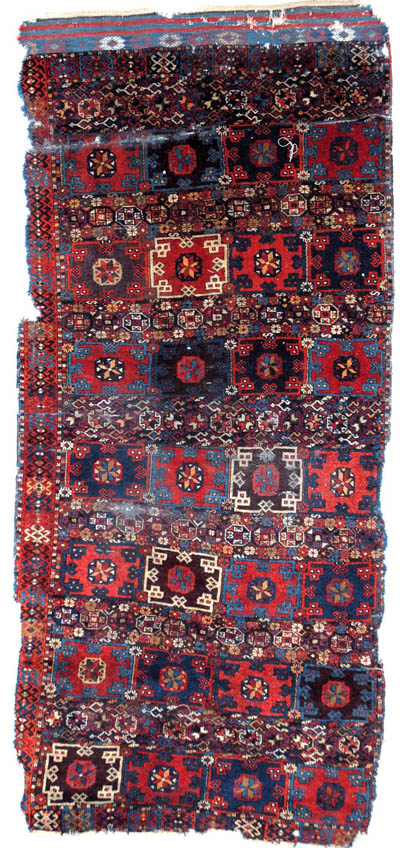
And a very Kazak-looking
piece that very well could be Armenian:
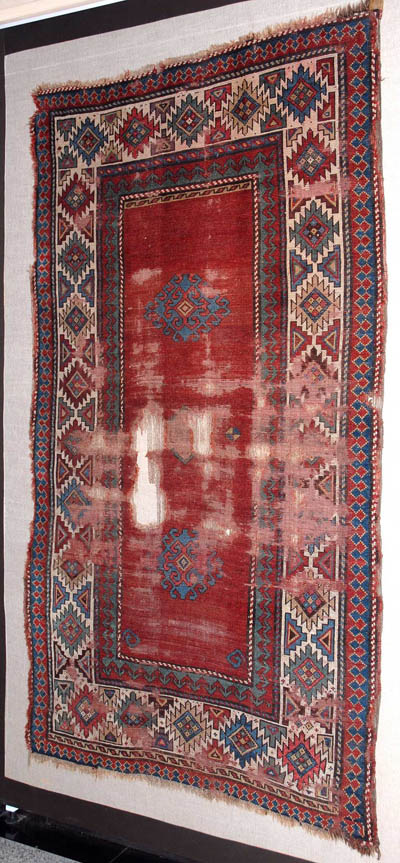
And finally, a very orange
prayer rug:
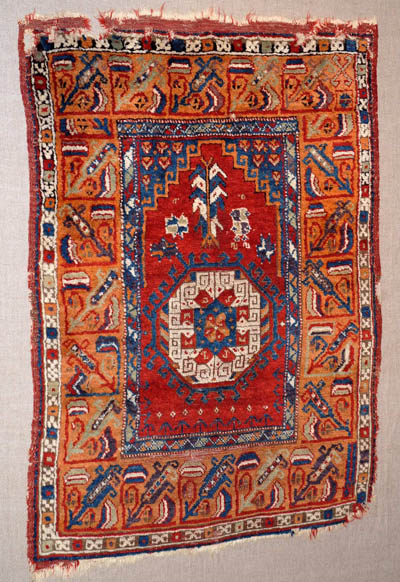
The quality of this last piece is suspect, but note the "dice"
border and the major gul that looks like it came from an Abadeh version of an
old Qashqai rug.
I will send a couple more batches of these rug photos to
Steve. Maybe we can generate a lot of heat, a little light and ignite a few
controversies.
Patrick Weiler
Posted by Wendel Swan on 07-16-2007 09:10 PM:
Hi Pat,
I believe that the primary border has been mentioned several
times here on Turkotek.

At the 8th ICOC in Philadelphia in 1996, I presented a paper
entitled “The So-Called Leaf and Wineglass Border in Anatolian and Caucasian
Rugs” in which I demonstrated (well, at least I think I did) that the “leaf and
wineglass” border represents neither a wineglass nor a leaf, but results from
the process of halving this border or others similar to it. I illustrated the
point with other rugs using this border type, including one in which three of
the borders are complete (as here) and one is halved. There are several other
points of correspondence as well.
The term “leaf and wineglass” is an
unfortunate example of a pattern being named according to representations that
Western eyes think they are seeing – but aren’t there at all.
That paper
was published in Oriental Carpet and Textile Studies, Volume 5, Part 1. I’ve had
been tell me that they disagree with my analysis, even though they haven’t read
the paper or viewed any of the 36 illustrations. It apparently still doesn’t
seem odd to them that Muslims would adorn rugs with representations of a wine
glass. They hold to the belief that it must be a wine glass because that is what
it is called. Years ago the wineglass was sometimes called a tuning fork, almost
equally absurd.
Others, including one who posts here prominently,
routinely say that it serves no purpose to discuss or propose anything about
design evolution because it simply cannot be proven.
Wendel
Posted by Patrick Weiler on 07-16-2007 09:25 PM:
I'll Drink To That
Wendel,
I suspect that much of what passes for scholarship in rug
studies is based on less than what you have presented and what I have also
postulated. The foundation of rug knowledge, from the late 19th century until
after the mid 20th, consists of market lore, dealers' tales and fanciful
speculation.
There is considerable resistance to acknowledging research that
counters common misconceptions.
Patrick Weiler
Posted by Steve Price on 07-16-2007 09:38 PM:
Hi Wendel
The practice of naming a motif or design with terms
reflecting something familiar doesn't necessarily imply that the observer thinks
that this is what it represents. There are probably some who think the
"wineglass and leaf" border actually represents wineglasses and leaves, but most
just use the term as a convenient descriptor. There are lots of examples of
this. Latchhooks, for instance, or beetles. I doubt that anyone thinks the
"latchhook" device is really a representation of latchhooks, and I don't think
I've ever seen a claim that the design on "beetle bags" actually represents a
beetle. Likewise for the "tuning fork" on some Turkmen ensis, the "bow tie" on
some Turkmen borders, and the list goes on.
I think these are useful
shorthands in communication, although they do occasionally get taken too
literally, mostly (but not exclusively) by novice collectors.
Design
evolution can sometimes be dealt with in reasonably convincing ways - Horst
Nitz's recent Salon is a good example. More often than not, though, proposed
evolutionary pathways are so speculative as to have little value, especially
when the subject becomes (as it too often does) the starting point of the
pathway - design origin.
Regards
Steve Price
Posted by Richard Larkin on 07-16-2007 10:03 PM:
Patrick,
Are you saying that they deliberately put in the red
corrosive dye, knowing it would corrode away to leave the famous Baluchi
design motif! Migawd, this is unbelievable stuff!
Really, though, I
cannot see that eight pointed star in there. I love them, and I've seen enough
elsewhere to get my astronaut badge, but not in that brocade. I'll blow up the
picture and work on it.
I love the Eastern Kurdish divan cover. My kind
of rug. About the orange prayer rug. Are you pretty sure it's bad? There's
orange and there's orange...
__________________
Rich
Larkin
Posted by Patrick Weiler on 07-17-2007 09:49 AM:
Deliberately Crude?
Richard,
The orange rug is old, but crudely woven. I was quite
surprised to see so much orange in Anatolian rugs of considerable age, hundreds
of years old. As for the red in the brocade, perhaps I can send Steve the
close-up photo in a bit of a larger size. The "missing red" appears to have been
worn away rather than corroded.
The divan cover was spectacular and I took a
close-up, but it is out of focus.
Patrick Weiler
Posted by Richard Larkin on 07-17-2007 10:36 AM:
Hi Patrick,
Some of my best friends are crudely woven rugs. Nothing
necessarily wrong with that. As to the orange, I know John has remarked more
than once recently that the Turkish dealers insist a lot of that orange is good.
The orange in your image seems to have that tinge of apricot we want so
desparately. Not sure whether that's the rug or just my monitor. I do like that
Abadeh style "endless knot."
If you could get a larger (closer) version
of the brocade device on the screen, I'd be obliged.
__________________
Rich
Larkin
Posted by R. John Howe on 07-17-2007 02:32 PM:
Rich -
The Turkish dealers' position on orange is distinctive from "a
lot of orange is good."
They know that orange is widely decried, and seen
with deep suspicion, by many rug collectors.
What the Turkish dealers
know, from the pieces in their museums, is that rugs that are 13th century can
have bright oranges that most collectors would reject.
They know that
"brightness" of a color (orange included) is not necessarily a sign that it is
from a synthetic source.
A Bohmer footnote: I am currently reading his
book on natural dyeing and he argues (I encountered this from him in another
source once) that the thing that is distinctive about synthetic dyes is that
they can project a purity of color that natural dyes cannot achieve.
Natural dyes, Bohmer argues, always contain shades of close analgous
colors (he doesn't use that precise word) and this makes them more complicated
and interesting to the eye. He says this complication does work to "mute" the
basic color somewhat and also contributes to "color harmony." Natural colors
tend not to clash because they often contain lots of each other in
themselves.
So for him it is the "purity" rather than "brightness" that
should be the source of suspicion that a given color in a rug might not be from
a natural source.
Regards,
R. John Howe
Posted by Richard Larkin on 07-17-2007 03:06 PM:
Thanks, John. Very interesting. I wonder whether he was referring to the
entire range of synthetic dyes through history (on the issue of purity of
color), or to modern dyes only.
__________________
Rich
Larkin
Posted by R. John Howe on 07-17-2007 07:10 PM:
Rich -
He doesn't talk about it in this way. Here's his most direct
sentence. "Monotone, and therefore always reproducable, colour tones are the
goal of dyeing with synthetic dyestuffs and are considered - when acheived - to
be a mark of quality."
His book "'Koekboya:' Natural Dyes and Textiles, a
Colour Journey from Turkey to India and Beyond, 2002, ISBN 3-936713-01-4, is a
very impressive piece of work. I'm thinking of trying to review it on Turkotek,
but that's going to be difficult and not just because I know little about dyeing
with natural substances. It's a very wide-ranging, quite beautifully produced
book that would be hard for me to characterize usefully. But I might still try.
Have to read it first.
Regards,
R. John Howe
Posted by Richard Larkin on 07-17-2007 09:20 PM:
Ambitious. Bravo!
__________________
Rich
Larkin
Posted by Patrick Weiler on 07-18-2007 01:24 AM:
More Ankara Vakif Rugs
Here are a few more rugs from the Ankara museum. Most are conditionally
challenged, but thanks to the tremendous efforts and investments of many
restorers, conservators and Turkish officials, these pieces were not only
collected and saved, but conserved and put on display. Over the years I have
read of the disastrous conditions many of these pieces were kept in and the
exhortations of rug collectors and dealers for the Turkish government to take
better care of their patrimony. If you think how much money it takes just to
conserve one rug, think of the investment that has been incurred to bring this
irreplaceable legacy back to the public.
This first piece has the same
design of 8-pointed stars in the main border as the earlier brocaded piece. I
think it is a Kula or Makri rug:
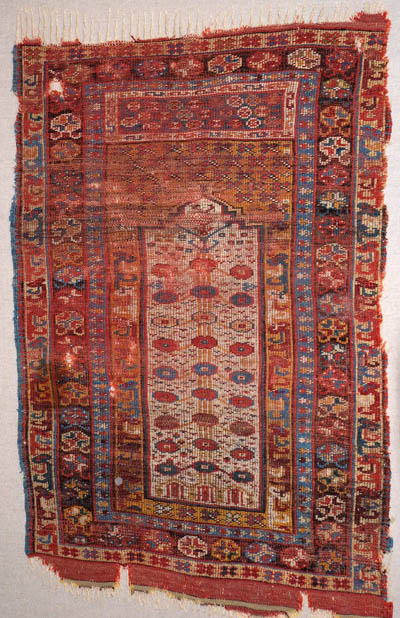
The next one has an interesting
border design:
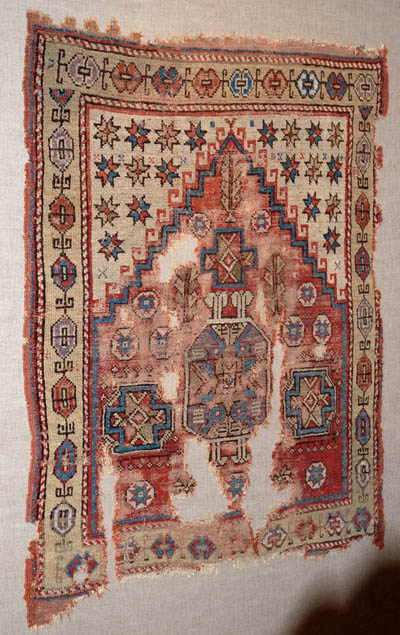
The panel above the mihrab here has what we have traditionally
called a "cloudband", but whose true source of design inspiration is obviously
an octopus. Also note the resemblance of the head of the octopus to that Farsi
or burning bush Baluch design shown on the Show And Tell thread:
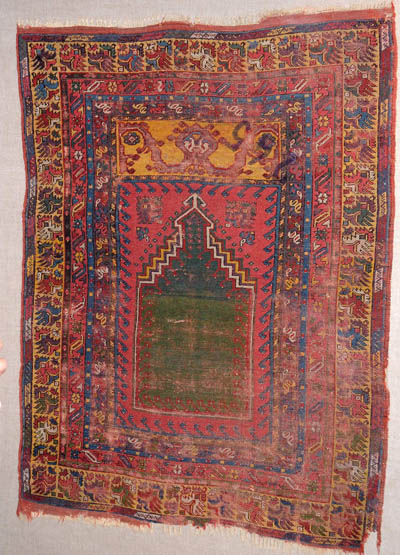
And the main border of
this piece somewhat resembles the field devices in Tekke engsis:
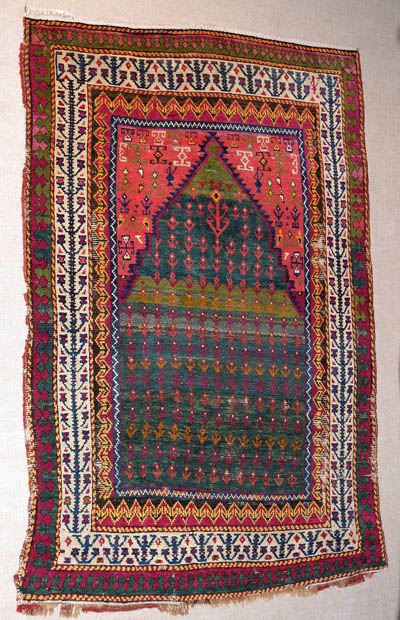
Here is a rug with the
traditional and common "460" design found in modern Baluch rugs,
too:
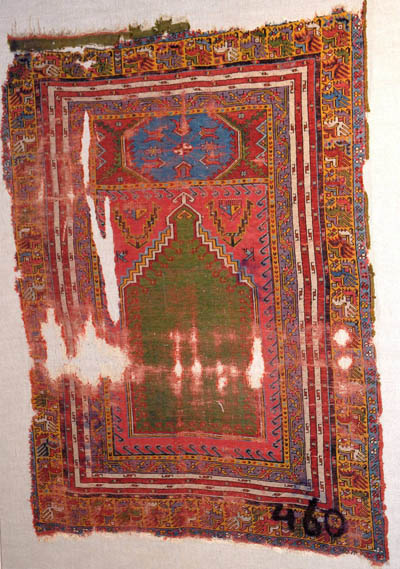
OK,
there is no such thing as the traditional Baluch 460 design. I just made that
up. To see if you were paying attention.
And I love this oddball little
piece. It has a little birdhouse on a tree:
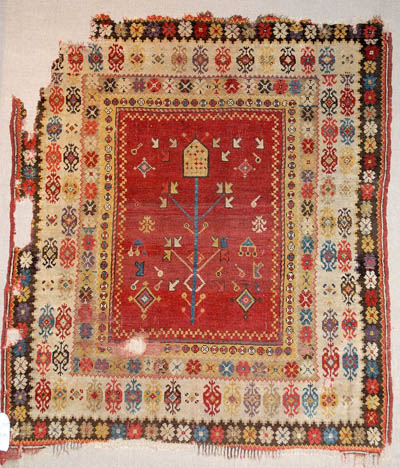
Patrick Weiler
Posted by Marty Grove on 07-18-2007 08:28 AM:
Sameness
Patrick,
In your last Turkish post there are two rugs, No3 and No5
which display great similarity in colours and their main border, and even
something in the form of the minor stripes which to me, seem that they may have
been woven by the same weaver - or if not, then perhaps the same workshop or
village.
Is this a fairly common occurance to see two very old rugs which
remain extant and showing basically the very same
colours?
Speculatively,
Marty.
Posted by Marty Grove on 07-18-2007 01:02 PM:
Encouragement
Oh gee everyone, seems Ive generated my usual blankness - come one, surely there others who can
see how much the two resemble each other without having to point out all the
other similarities?
- come one, surely there others who can
see how much the two resemble each other without having to point out all the
other similarities?
I thinks its just wonderful to imagine how two rugs
woven who knows how many years ago (obviously a LOT!) by possibly the same
weaver or whatnot, to arrive in the same place how many years
later...
These are two which probably resided somewhere within the
precincts of an ancient mosque, maybe having been given by the same person,
perhaps at different times, and had been eventually brought/bought out into the
wider world where they came together again. There are endless possibilities, but
I bet that there would be a fairly decent provenance if they are on public
display within or from a museum collection.
Whatd'ya
reckon?
Marty.
Posted by Steve Price on 07-18-2007 01:15 PM:
Hi Marty
I had no trouble seeing the family resemblance between those
two rugs once you pointed it out, just didn't have anything useful to say about
it. Probably the same for some other readers.
There can be amazing
congruence within some kinds of weavings. Perhaps most striking is the so-called
Dokhtor-i-Qazi Belouch prayer rugs. Early examples (I doubt that anyone really
knows whether this means early, mid or late 19th century for these rugs) are
similar in all sorts of seemingly trivial details, and differ significantly only
in the filler devices in the area between the mihrab and the borders. There is a
similar level of uniformity in Tekke ak-juvals. My recollection is that both
have been the subject of salons; a Google search of our archive will probably
turn them up pretty easily.
Regards
Steve Price
Posted by Marty Grove on 07-18-2007 01:44 PM:
Thanks Steve, it also probably goes to show just how many old rugs maybe from
the same place remain out there.
We used to say at home that there seemed
rarely to be two rugs which looked alike (excepting Turkmen pieces), but that
idea didnt remain with me very long
These two rugs, to me, will always be brothers, especially
because of the colours which remain strong even after all this time, and the
treatment of the mirhab. It probably is quite true they were unlikely to be from
the same weaver, and near impossible to be conclusively proven, even if worth
the finding out, but to me personally, its a wonderful rareity to be able to
think it anyway.
Regards,
Marty.
Posted by Patrick Weiler on 07-19-2007 01:36 AM:
Same Bat Time, Same Bat Place
Marty,
Good eye!
Both of those rugs were probably woven in the
same region of central Anatolia, probably within a hundred or so years of each
other and within a hundred or so kilometers. The major colors, main borders,
large panel above the mihrab, spandrel treatment, mihrab shape and design, and
on and on all indicate a similar area of production. Mudjar, Kirsehir,
etc.
You will be hard pressed to find one of this age or quality on the
market today. Your conjecture that:
"These are two which probably resided
somewhere within the precincts of an ancient mosque" is quite likely.
Patrick Weiler
Posted by Richard Larkin on 07-19-2007 08:01 AM:
Hi Marty,
I haven't been able to figure out which bunch of rugs it is
that has the two similar ones. Apparently, Steve and Patrick figured it out.
Which post?
__________________
Rich
Larkin
Posted by Richard Larkin on 07-19-2007 08:07 AM:
Patrick,
I hate to admit it, but you are a funny guy. I was zeroed in
for about a minute on the blue octagon trying to figure out how it resembled the
traditional "460" design made eternal by the Baluch. Then my eye dropped to the
lower right corner. I do officially protest on behalf of the Baluchi ambassador,
however.
I repeat, it is great to see all these varied old Anatolian
village rugs, the like of which we haven't seen for the most part. New and old
at the same time...a ruggie's dream. Thanks again for the effort.
__________________
Rich
Larkin
Posted by Marty Grove on 07-19-2007 09:00 AM:
Similar
Thanks Patrick; although there are many many pieces which resemble each other
and can be said to come from the same or similar 'atelier' and/or district, like
those from Heriz etc and the Turkmen rugs, with the Caucasians/Shirazi/Isfahans
'district'ly so to speak also having a sameness, I must admit that the rugs from
Turkey had not struck me quite in the same way as having so close an appearance
between them.
Richard, you were looking at one of the rugs I mentioned,
which has the ugly black '460', that one, miss the one above it, and the one
above that is the other which I had thought to carry such colour and details
which prompted me to think perhaps they came from the same
weaver.
Regards,
Marty.
Posted by Patrick Weiler on 07-19-2007 10:58 AM:
Together Again
Richard,
Here are the two rugs of the now internationally famous "460"
type, together once again. I only threw in the Baluch remark to needle the
Turkotek "Baluch minority party" members who have been known to filibuster the
occasional thread until the original intent of the thread has been abandoned. It
could be an attempt to gain Turkotek majority status by showing overwhelming
numbers of Baluch rugs until their nefarious intent is succesful. I say we just
pander to the Baluch party and hope they remain restive but under control.
Otherwise we may find ourselves under seige by, say, the Indo-Persian
contingent, or the Sino-Silk party.
I have no idea why that number is on the
rug, but it was not removed during conservation - probably because it would have
damaged the rug.


Marty, there are some
antique rug "types" from Anatolia that are instantly recognizable, such as the
Transylvanian rugs, Ushak rugs, Bergama, etc, but most of the really old ones
are gone and only a few remain in museums or private collections. Many types
were an evolutionary dead end and were no longer made after they went out of
fashion or their makers were "removed" from the area. Thus, the remaining few
are not often seen in great enough quantities to be recognized as a
"type".
I will look through my photos to see if I took any more of this
type.
Patrick Weiler
Posted by Filiberto Boncompagni on 07-19-2007 12:01 PM:
quote:
I only threw in the Baluch remark to needle the Turkotek "Baluch minority
party" members who have been known to filibuster the occasional thread until
the original intent of the thread has been abandoned. It could be an attempt
to gain Turkotek majority status by showing overwhelming numbers of Baluch
rugs until their nefarious intent is succesful. I say we just pander to the
Baluch party and hope they remain restive but under control. Otherwise we may
find ourselves under seige by, say, the Indo-Persian contingent, or the
Sino-Silk party.
Fear not, dear Patrick,
We’ll fight the Baluchinfidels just
like the heroic 3rd Foot and Mouth Regiment did.
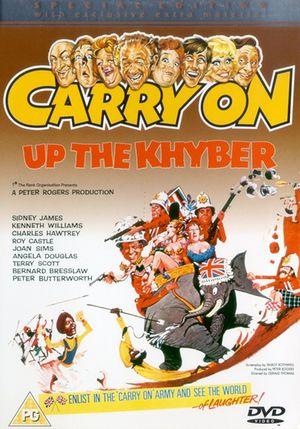
Ciao,
Filiberto
Posted by Marty Grove on 07-19-2007 12:25 PM:
Thanks muchly Patrick, seeing them together certainly brings a 'type' into
the picture.
Although the two panels above the mihrabs differ in their
object, that of the first, which you described, and I think accurately, as an
'octopus', might suggest this particular rug may perhaps come from somewhere
closer to the coast than further east.
Although not getting much from the
blue panel in the second one alongside, it doesnt detract from the more obvious
similarities which bring them together sufficient to maybe call them a 'type',
or as I perhaps might wish, products from the same weaver and/or
village.
The colours of the two seem so very similar as to have one think
the same dyer made them, in which case it would be interesting to know if it was
usual for Turkish weavers to often make their own, or more often buy the wool
already dyed, from the village weaver.
Even still, if from the local dyer
who may have had his product used by a number of different weavers within a
locale, we are still unlikely to find out if the rugs were made by the same
weaver or not. Might it be determined from an analysis of the structural details
which could possibly be procured from the Museum?
Not that I believe it
is particularly important, just that sighting their sameness struck a cord with
me and niggles, and thinking it might be wonderful to find two products possibly
from the same weaver.
Although their condition differs markedly, one
having been distressed far more, doesnt really say anything, other than one may
be older, or less cared for over the duration of its life.
Looking at the
colours, is it possible that two rugs could carry such similiar nuances unless
from the same dyer - I mean, did/do dyers have such strict recipies that they
can deliver exactly the same colour time and again? And that those colours would
age in the same fashion, delivering them to the stage we see them at now? One
would think if so, that the wool would also have to have been similar in spin
and origin, lanolin content etc for those colours to display so closely today,
after possibly centuries.
The idea fascinates me, and its only from my
position of total ignorance that I am able to speculate so
willingly...
Regards,
Marty.
Posted by Marty Grove on 07-19-2007 12:42 PM:
G'day all,
Aint it amazing that we can looks till the cows come home
and still not see something directly in front of our faces ...  I have just now noticed that the
'octopussy' rug is also numbered, 765 or 265 possibly; so they should then have
come from possibly the same 'picker' or dealers catalogue in the fashion those
numbered for the Dutch business in a previous thread on Turkotek ages
ago.
I have just now noticed that the
'octopussy' rug is also numbered, 765 or 265 possibly; so they should then have
come from possibly the same 'picker' or dealers catalogue in the fashion those
numbered for the Dutch business in a previous thread on Turkotek ages
ago.
What sort of person would destroy the pictorial image of a rug by
numbering them on the front, rather than the back! Blimey, there were/are some
dopes around arnt there (including moi )!?
)!?
So these two may have come from the same origin anyway, heh
heh. Yah, ya rugnut, Turkey!
Marty.
Posted by Unregistered on 07-19-2007 03:24 PM:
Re: Sameness
quote:
Originally posted by Marty Grove
Patrick,
In your last
Turkish post there are two rugs, No3 and No5 which display great similarity in
colours and their main border, and even something in the form of the minor
stripes which to me, seem that they may have been woven by the same weaver -
or if not, then perhaps the same workshop or village.
Is this a fairly
common occurance to see two very old rugs which remain extant and showing
basically the very same colours?
Speculatively,
Marty.
This is because the two of the rugs appear to have been cartoon
drawn workshop pieces.
Haroun Al-Rasheed
Posted by Steve Price on 07-19-2007 03:52 PM:
Hi Haroun
When you post, please overwrite the word "unregistered" in
the user name field with your name. Thanks.
I don't think they are done
from cartoons. If they were, they would have an axis of symmetry. Although they
are more symmetric than most, and the corner resolution is nearly perfect, you
can see that the corner resolution was achieved by using a partial motif in the
upper and lower horizontal borders of each of them. The latchhooks in the upper
part of the field of one are symmetric, as would be expected if done from a
cartoon, but the latchhooks in the lower part of the field aren't symmetric in
either rug.
Interesting thought, though.
Regards
Steve
Price
Posted by Patrick Weiler on 07-19-2007 11:08 PM:
Phinal Photos
This is the final set of pictures of rugs and kilims from our ICOC trip.
These are also from the Ankara Vakif museum. I did not find any more of the
Antique Anatolian Marty Grove type.
This one has Transylvanian cartouches
in the border, stars in the field and carnations in the cartouches.
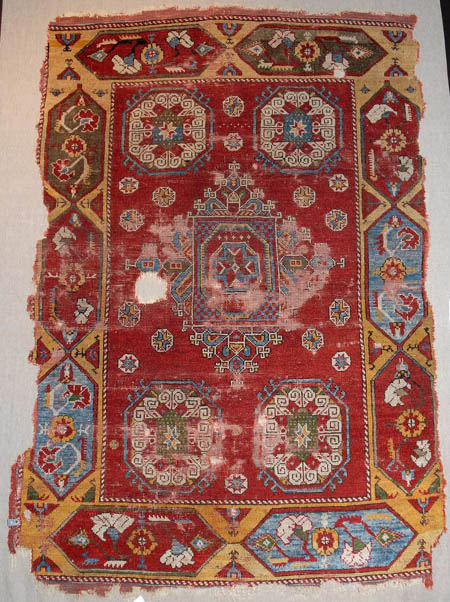
The inner border here
changes from white to dark blue. It has an Eastern Anatolian color and look. Jim
Burns might say it represents a Kurdish rendition of a Persian garden
design.
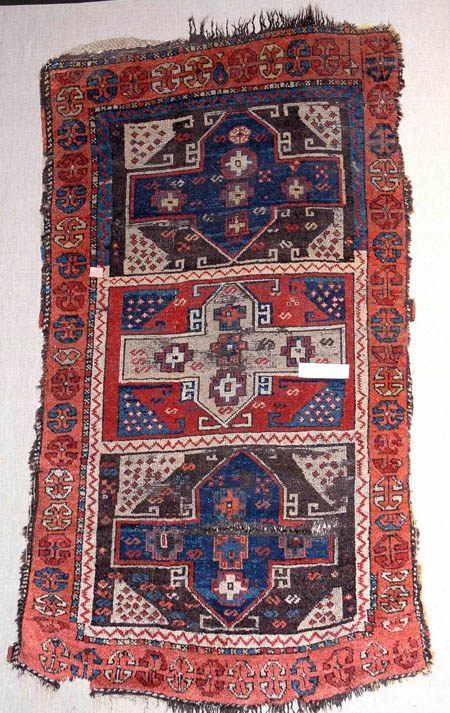
Here
we have lotus flowers floating around a lily pad.
(sure, right, another
undocumented design attribution)
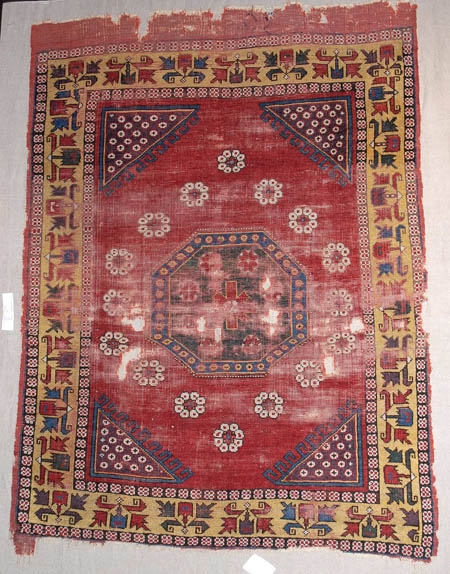
This Ladik suffered from a
cannon blow during one of the more tempestuous times in Turkey. The soldier
carrying it died, of course, and was buried at the mosque where the rug was
donated. I think. Probably.
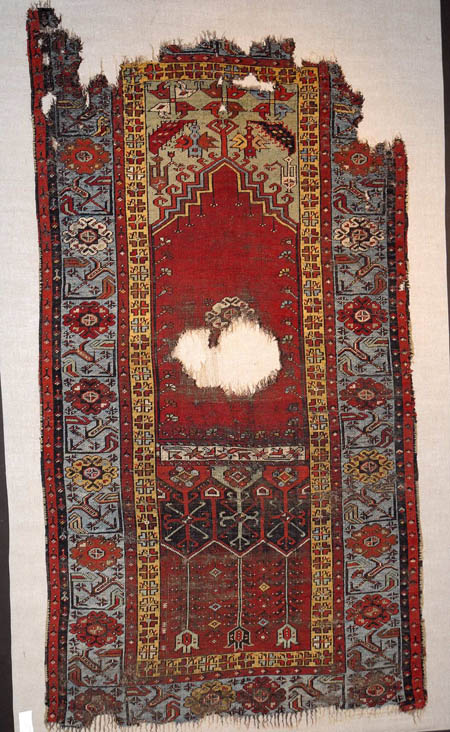
Another Baluch with Turkmen-related designs.
OK, it is NOT a
Baluch, truce OK?
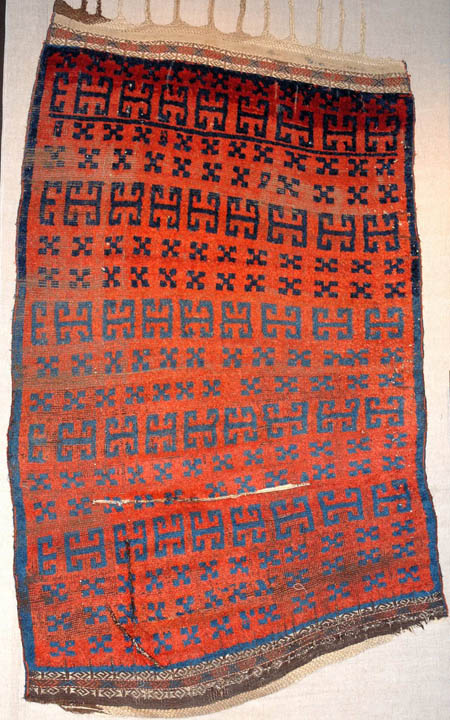
And, finally, a reminder of how enlightening our journey was.
This is a display of lamps at a stall in the Grand Bazaar.
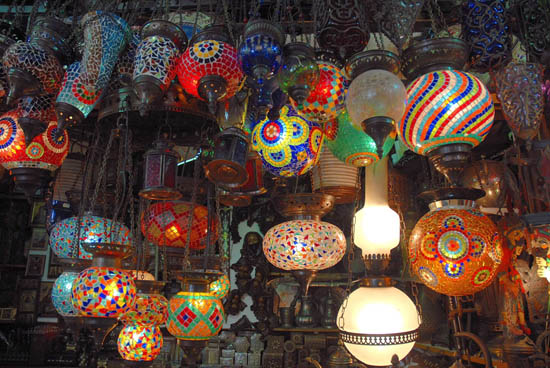
Marty, I am afraid you will have
to travel to Ankara yourself to check the backs of those prayer rugs. It may be
a while before I return.
Filiberto, I suggest you convene the first
Defense Against the Baluchotek party meeting at your eponymous restaurant. I
will get a table for two or three, that ought to do it.
Patrick
Weiler
Posted by Wendel Swan on 07-20-2007 08:34 AM:
Hi Pat,
The first is fabulous, just fabulous and quite early. The
third is just a tad below the first, but the other three range from unimpressive
to nice but standard variety (as in the Ladik).
In the first, the
carnations in profile in the cartouches are unusual. But, then, the whole rug
is. Within it, one can trace design techniques back to the Mamluk rugs and
forward to contemporary Turkish weavings.
This is why being able to see
the centuries of historical carpets in Turkey is such a valuable learning
experience.
I'm sorry I missed that trip. One day.
Wendel
Posted by Gene Williams on 07-20-2007 07:18 PM:
Response from Baluchotek
LESS FILLING.
Posted by Richard Larkin on 07-21-2007 08:04 AM:
Hi Patrick,
I just love the way those Kurdish weavers did their rugs
any old way they felt like, and this one here is a prime example. That border
around the three panels looks more like my EEG than a border, and of course they
went and did the blue/white switch. And the cockeyed medallions.
Wild.
The border of the piece with the eight-lobed devices surrounding
the octagon (lily pad) is a winner. Has that been seen often? I think I've seen
it before, but not as nicely drawn as this one. (I'm not as up on my Turkish
rugs as I should be.)
Coincidentally, my upcoming novel is a thriller
based on how a gang of insurgents is trying to infiltrate and take over
TurkoTek. The thriller aspect is that there is a brilliant but sinister mole in
the picture who is masterminding the effort, but nobody suspects him.
 It's Steve!! Notice
how he responded to Marty's perfectly innocent question about a couple of
similar rugs, and went directly to the Dokhtor-i-Qazi? Wow! Who'da thunk
it!?
It's Steve!! Notice
how he responded to Marty's perfectly innocent question about a couple of
similar rugs, and went directly to the Dokhtor-i-Qazi? Wow! Who'da thunk
it!?
BTW, what do you know about the provenance of the last rug in the
string, just before the picture of all the lamps? I know it isn't Baluch, but do
you know what it is? You didn't happen to handle it or inspect it closely, did
you?
__________________
Rich
Larkin
Posted by Steve Price on 07-21-2007 09:03 AM:
Hi Rich
You blew my cover. Now I have to kill you. Make an
appointment.
Steve Price
Posted by Richard Larkin on 07-21-2007 09:16 AM:
I will, Steve, as soon as I've fixed all these slightly used Baluch rugs I've
been planning on repairing. Might take awhile.
__________________
Rich
Larkin
Posted by Jack Williams on 07-21-2007 09:36 AM:
Double agent, or coming in from the cold.
…or “great tastes”… Patrick, you are doing a great job getting “their”
confidence…keep up the good work and continue passing the details of their evil
plans. That way, we, Baluchotek nation, will know when to strike, divert, or
subsume a line that is threatening to go solo.
I do appreciate it when
Wendel, Patrick, et al illustrate why certain village Turkish rugs are better,
more attractive than others. Left to view these without a scout, it is hard for
me to get a sense of balance that is more than purely impressionistic. I wonder
if this is because the borders of Turkish rugs sometimes seem a little
overpowering compared to their country cousins? (I actually own one old(?)
Bergama prayer rug).
The design of the field of the third rug, with the
flowers floating around the lily pad, reminds me of a pattern I think I’ve seen
a lot in the more untamed outback Turkmen group rugs, … and the scheme
might have occasionally okkurd in the designs of non-Turkmen, unnamed.
I’ll forego the analogies.
Patrick, that picture of the Turkish lamps may
have answered a question about the field design of a rug I looked at some time
ago. It isn’t a great work of art, but…. I don’t know what the rug is, or what
the field represents, but the lamps seem reasonable.
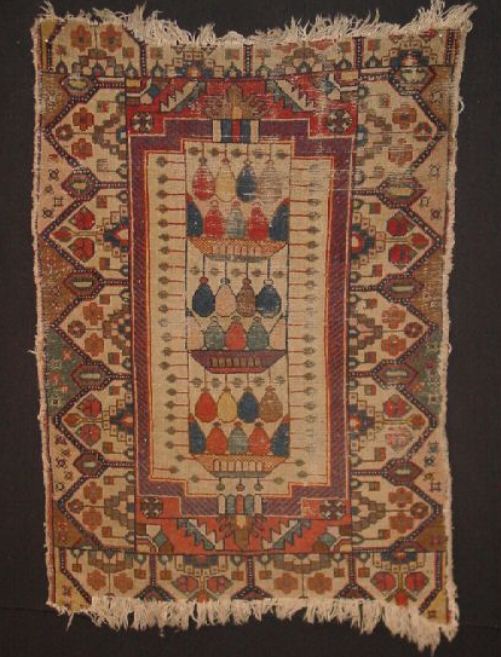
In any case, I enjoy seeing
rugs that diverge from the main stream of rug collecting, Baluchomania. I
certainly enjoy these, a lot more than…say…Halloween gorilla suits, sofa
comforters, or macramé. But that is just my opinion…which is one thing that
everyone has
Regards, Jack Williams
Posted by Patrick Weiler on 07-21-2007 11:28 AM:
Jack,
It is not surprising that a lot of these ancient Anatolian
designs seem familiar to collectors of more modern "antique" rugs. It is not
that they are necessarily the direct ancestors, but that to a great extent they
are the only remaining ancient rugs of any quantity and variety remaining for us
to compare with. If a similar quantity of equally aged Persian rugs, or
Caucasian rugs still existed we may also see vestiges of their designs on modern
rugs as well. We do not know either the origins of many of these designs or
where the designs traveled to before ending up on our Saryk or Jaf or Kurd or
Bijar.
Oh, sorry, or Baluch too.

Richard, that lily pad rug border is definitely striking. The
weaver was unable to resolve the corners, so we assume it was a village or rural
weaving, perhaps based on a more urban prototype. I would appreciate it if you
could research that and report back within the week. After you finish repairing
your pile of Baluch rugs.
That last rug has the Yuncu look about it, but
there were no tags on any of these rugs at the Ankara museum. It is possible
that they plan to add tags later, because the museum was not entirely ready for
their Grand Opening. We were allowed a pre-completion visit because of our ICOC
connection. Suzan Bayraktaroglu, who gave one of the ICOC academic sessions (on
the vakif museum in Tokat) was our guide at the Ankara museum. She is also
spearheading the establishing of a dozen General Directorate of Foundations
museums to contain vakif donations throughout Turkey.
They were still hanging
many of the rugs. We only got to see the smaller rugs and kilims on one upper
floor and they were still under construction. We saw piles of larger kilims in
one area that were being prepared for hanging and incomplete flooring, lighting,
wall finishes etc. It will be a stunning museum for rug enthusiasts when it is
complete.
Not to add a political tone to this, but there was a bombing within
a block of the museum a couple of weeks after our return, and there was a
protest of nearly a million people in Ankara the day we were there over the
upcoming elections.
Our bus tour of Central Turkey was a whirlwind of both
typical tourism and focused rug stops. From the underground cities of Cappadocia
to the Dervish mosque and museum in Konya to the tremendous variety of
restaurants (many of which were down narrow alleys, up formidable, narrow
stairways, through unmarked doorways) these tourist visits combined with trips
to the vakif museums, felt and rug manufacturing facilities, rug stores and
markets to result in a very memorable and probably impossible to duplicate
experience. We stayed one night in Tokat at a brand new hotel that was not even
open yet to the public. We rode through snow in the mountains. We took a wrong
turn and spent a couple of hours on the wrong road - being stopped once at a
government checkpoint looking for who knows what. But, at all times we were kept
safe by the Evil Eye protector jangling at the front of the bus.
Patrick
Weiler
Posted by Patrick Weiler on 07-21-2007 10:49 PM:
Kurdotek
Jack,
The picture of the rug you posted was not visible (at least to
me) until just now. I do not know if you have an attribution. But, of course, I
do!

Baluch, 18th
century.

Oops,
wrong thread!
I have a Kurdish piece with the same inimitable motif in the
major border of your piece.
I call it the "pencil" motif.

It looks like the stub of a
pencil, with a point at one end and an eraser at the other.
"History of
the Lead Pencil
Lead pencils, of course, contain no lead. The writing medium
is graphite, a form of carbon. Writing instruments made from sticks cut from
high quality natural graphite mined in England and wrapped in string or inserted
in wooden tubes came into use around 1560. [1] By 1662, pencils were produced in
Nuremberg, in what is now Germany, apparently by gluing sticks of graphite into
cases assembled from two pieces of wood. By the early 18th century, wood-cased
pencils that did not require the high quality graphite available only in England
were produced in Nuremberg with cores made by mixing graphite, sulfur and
various binding agents. These German pencils were inferior to English pencils,
which continued to be made with sticks cut from natural graphite into the
1860s."
http://www.officemuseum.com/pencil_history.htm
I will
download a photo or two in the next day or so.
Patrick Weiler
Posted by Richard Larkin on 07-22-2007 12:45 AM:
Hey Jack,
Are you kidding me? If that isn't a work of art, what is?
What is it, by the way. How do you feel about the colors? How about a little
info on the materials, weave, size? Can we get a look at the back?
__________________
Rich
Larkin
Posted by Jack Williams on 07-22-2007 01:34 AM:
OMG...someone else likes it?
Rich,
I hope you are serious, because your interest and appreciation
will restore my confidence in my eye. On this piece, to my everlast
sorrow I listened to my brother who sniffed that it was not traditional
anything therefore was probably just some polygot rag...basically he
panned the piece...after I spotted it early in an obscure location and had
watched it for a week. My confidence shattered, I didn't bid and it went for
a song...to my regret.
I know nothing about it, though I know the
dealer. my other excuse was that I had used my budgeted money on two really
terrific Timuris that week...however, that is lame at best.
If as Patrick
says, it contains the rare weaver's "pencil and eraser" emblem and presumably
uses that methodology, repairing weaving mistakes must be simple. Here is an
example of using the eraser repair method to fix a border. Too bad the method
cannot be applied to some of the bang-a-gong things we have reviewed
lately.
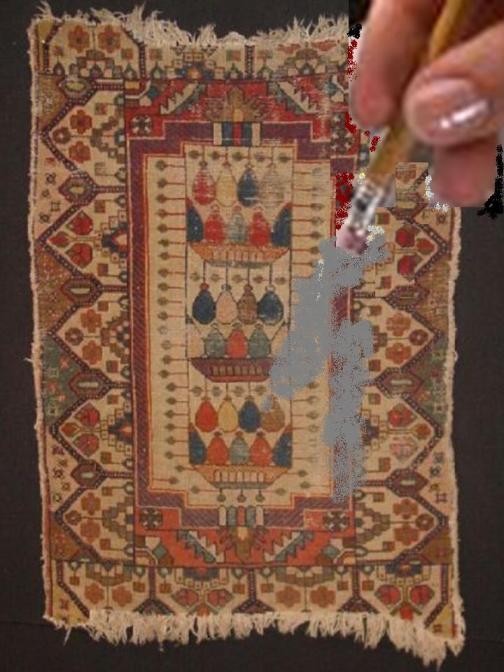
Regards, Jack Williams
Posted by R. John Howe on 07-22-2007 07:38 AM:
Hi Pat -
Just to follow the main line here (this is the "pencil
thread" isn't it?) there's a 500-page "History of the Pencil," by a Duke
professor. Good read.
http://www.amazon.com/Pencil-History-Design-Circumstance/dp/0679734155
This
book is full of odd pencil facts. Thoreau's family were pencil manufacturers and
Thoreau himself held patents to some pencil-making machines.
Thoreau was
a great list maker, and never without a pencil, but his list of what to take to
Walden Pond does not include a pencil. Maybe too obvious.
When you finish
that one you can move to his history of the bookcase. Another
thriller.
Regards,
R. John Howe
Posted by Richard Larkin on 07-22-2007 09:45 AM:
Hey Jack,
Well, I was probably spoofing slightly when I said it was a
monumental work of art, but that rug in a way is what I used to live to
find. Mind you, I said, "In a way." Of course, what I mainly wanted was a first
class Baluch, like any civilized hobbyist. But not too far back on the list
would be any rug with the following qualities:
-never saw anything like it
(mysterious origin);
-interesting design (a bit "off the wall" constituting a
bonus);
-could be pretty old;
-but if the color was atrocious, forget
it.
[also had to be cheap! ]
]
The rug in your picture seems to have most of the necessary
qualities. I assume it has cotton foundations. It's wild.
__________________
Rich
Larkin
Posted by Patrick Weiler on 07-22-2007 12:15 PM:
Write this down
Richard,
Your list of attributes for adding a piece to your collection
is a lot like mine, although for some inexplicable reason a number of my rugs
also have another characteristic. They make seasoned, wealthy, experienced
collectors Wince, Gag and Vomit.



(Hmmm, sounds like a law
firm)
Here is the border of my Kurdish piece with the "pencil" motif.
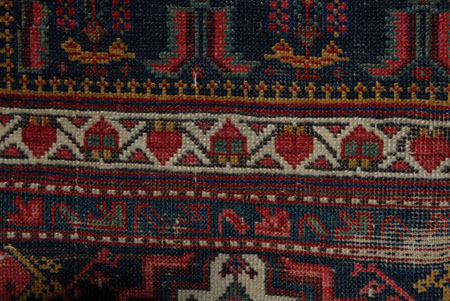
It is
probably just a geometric version of a reciprocating flower and vine type of
design. When I bought this piece, that border design looked unusual. For a few
years now, I have been looking for it again and it always appears on Kurdish
pieces.
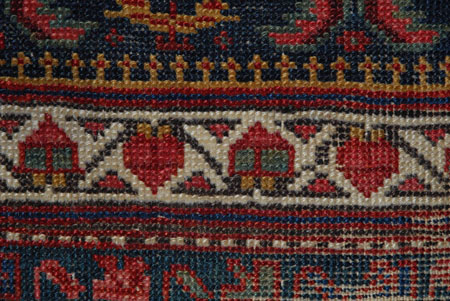
Jack,
in the rug you posted these "pencils" have become flowers on a tree. (pencils on
a post?)
Those balloon-like things could very well be lamps. Lots of prayer
rugs have a lamp in them, but those lamps are not quite like these.
I have
seen several of this type of rug you have posted and they mostly seem to be from
the early 20th century. There is probably a wealthy, eccentric collector buying
all of them up. It is not me, because I am not wealthy.......

Patrick Weiler
Posted by Richard Larkin on 07-22-2007 04:22 PM:
Patrick,
The wincing/vomiting phenomenon crops up in my experience,
too, but it happens in the post acquisition phase. I was referring specifically
to my stalking criteria.
It brings to mind the Kurdish non-Jaf rug corner
I posted with a few others a few days ago. There is a dubious story that goes
with that. I'll get into it some day, perhaps when the "My most preposterous rug
acquisition" salon goes up. It certainly shows strong under the wincing rubric.
__________________
Rich
Larkin










.jpg)
.jpg)

 )
)
































 - come one, surely there others who can
see how much the two resemble each other without having to point out all the
other similarities?
- come one, surely there others who can
see how much the two resemble each other without having to point out all the
other similarities?






 It's Steve!! Notice
how he responded to Marty's perfectly innocent question about a couple of
similar rugs, and went directly to the Dokhtor-i-Qazi? Wow! Who'da thunk
it!?
It's Steve!! Notice
how he responded to Marty's perfectly innocent question about a couple of
similar rugs, and went directly to the Dokhtor-i-Qazi? Wow! Who'da thunk
it!?




 ]
]


